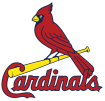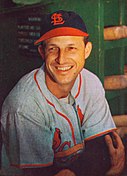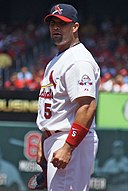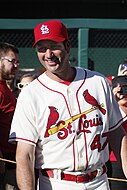St. Louis Cardinals
| St. Louis Cardinals | |||||
|---|---|---|---|---|---|
| |||||
| |||||
| Major league affiliations | |||||
| |||||
| Current uniform | |||||
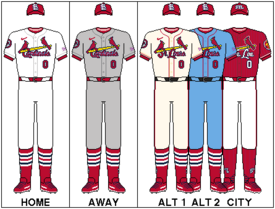 | |||||
| Retired numbers | |||||
| Colors | |||||
| Name | |||||
| Other nicknames | |||||
| |||||
| Ballpark | |||||
| |||||
| Major league titles | |||||
| World Series titles (11) | |||||
| NL Pennants (19) | |||||
| AA Pennants (4) | |||||
| Central Division titles (12) | |||||
| East Division titles (3)[d] | |||||
| Pre-modern World Series (1) | |||||
| Wild card berths (5)[e] | |||||
| Front office | |||||
| Principal owner(s) | Bill DeWitt Jr.[4] | ||||
| President | Bill DeWitt III | ||||
| President of baseball operations | John Mozeliak | ||||
| General manager | Mike Girsch | ||||
| Manager | Oliver Marmol | ||||
| Mascot(s) | Fredbird, Rally Squirrel | ||||
| Website | mlb.com/cardinals | ||||
The St. Louis Cardinals are an American professional baseball team based in St. Louis. The Cardinals compete in Major League Baseball (MLB) as a member club of the National League (NL) Central Division. Since the 2006 season, the Cardinals have played their home games at Busch Stadium in downtown St. Louis. One of the nation's oldest and most successful professional baseball clubs, the Cardinals have won 11 World Series championships, the most of any NL team and second in MLB only to the New York Yankees.[5][6] The team has won 19 National League pennants, third-most of any team behind the Los Angeles Dodgers and San Francisco Giants. St. Louis has also won 15 division titles in the East and Central divisions.
In 1881, entrepreneur Chris von der Ahe purchased the Brown Stockings barnstorming club, renamed it the St. Louis Browns, and made it a charter member of the American Association baseball league. The team won four league championships, qualifying them to play in the era's professional baseball championship series, a forerunner of the modern World Series.[7] In two of these championships, the Browns met the Chicago White Stockings, now the Chicago Cubs, launching the enduring Cardinals–Cubs rivalry.
In 1892, the Browns – also called the Perfectos – joined the National League. In 1900, the team was renamed the Cardinals. (Two years later, an unrelated St. Louis Browns team joined the American League.)
Notable Cardinals achievements include manager/owner Branch Rickey's invention of the farm system, Rogers Hornsby's two batting Triple Crowns, Dizzy Dean's 30-win season in 1934, Stan Musial's 17 MLB and 29 NL records, Bob Gibson's 1.12 earned run average (ERA) in 1968, Whitey Herzog's Whiteyball, Mark McGwire's single-season home run record in 1998, the 2011 championship team's unprecedented comebacks,[8] and Albert Pujols’ 700th home run. The Cardinals have won 105 or more games in four seasons and won 100 or more nine times. Cardinals players have won 21 league MVPs, four batting Triple Crowns, and three Cy Young Awards. Baseball Hall of Fame inductees include Lou Brock, Dizzy Dean, Bob Gibson, Whitey Herzog, Rogers Hornsby, Tony LaRussa, Joe Medwick, Stan Musial, Enos Slaughter, Branch Rickey, Red Schoendienst, Ozzie Smith, Ted Simmons, Bruce Sutter, and Scott Rolen.
In 2018, Forbes valued the Cardinals at $1.9 billion, the 7th-highest among MLB clubs and far more than the $147 million paid in 1995 by owner William DeWitt Jr.'s investment group. In 2017, the team took in revenue of $319 million on an operating income of $40.0 million.[9][10][11] John Mozeliak is the President of Baseball Operations, Mike Girsch is the general manager, and Oliver Marmol is the manager.[12][13] The Cardinals are renowned for their strong fan support: despite being in one of the sport's mid-level markets, they routinely see attendances among the league's highest, and are consistently among the top three in MLB in local television ratings.[14][15]
Through 2024, the Cardinals' all-time win-loss record is 11,285–10,402–152 (.520).[16]
History
[edit]Before the Cardinals (1875–1881)
[edit]Professional baseball began in St. Louis with the Brown Stockings of the National Association (NA) in 1875. The NA folded following that season, and the next season, St. Louis joined the National League as a charter member, finishing in third place at 45–19. George Bradley hurled the first no-hitter in Major League history. The NL expelled St. Louis from the league after 1877 due to a game-fixing scandal and the team went bankrupt.[17] Without a league, they continued play as a semi-professional barnstorming team through 1881.
The magnitudes of the reorganizations, following the 1877 and 1881 seasons, are such that the 1875–1877 and 1878–1881 Brown Stockings teams are not generally considered to share continuity as a franchise with the current St. Louis Cardinals.[18][19]
American Association and early National League eras (1882–1919)
[edit]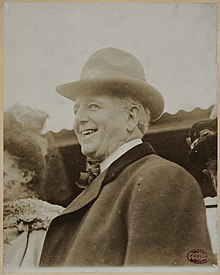
For the 1882 season, Chris von der Ahe purchased the team, reorganized it, and made it a founding member of the American Association (AA), a league to rival the NL.[20] 1882 is generally considered to be the first year of existence for the franchise which would later become known as the St. Louis Cardinals.[18][19][21][f]
The next season, St. Louis shortened their name to the Browns. Soon thereafter they became the dominant team in the AA, as manager Charlie Comiskey guided St. Louis to four pennants in a row from 1885 to 1888.[7][24] Pitcher and outfielder Bob Caruthers led the league in ERA (2.07) and wins (40) in 1885 and finished in the top six in both in each of the following two seasons. He also led the AA in OBP (.448) and OPS (.974) in 1886 and finished fourth in batting average in 1886 (.334) and fifth in 1887 (.357).[25] Outfielder Tip O'Neill won the first batting triple crown in franchise history in 1887 and the only one in AA history.[26][27][28] By winning the pennant, the Browns played the NL pennant winner in a predecessor of the World Series. The Browns twice met the Chicago White Stockings—the predecessor to the Chicago Cubs—tying one in a heated dispute and winning the other, thus spurring the vigorous St. Louis-Chicago rivalry that ensues to this day.[29] During the franchise's ten seasons in the AA, they compiled an all-time league-high of 780 wins and .639 winning percentage. They lost just 432 contests while tying 21 others.[7]
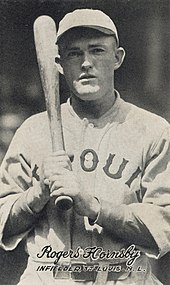
The AA went bankrupt after the 1891 season and the Browns transferred to the National League. This time, the club entered an era of stark futility. Between 1892 and 1919, St. Louis managed just five winning seasons, finished in last or next-to-last place sixteen times, and ended four seasons with 100 losses or more. The nadir was the 1897 season: a 29–102 record for a franchise-worst .221 winning percentage.[7] St. Louis' 84–67 finish as the Perfectos in 1899 would be the team's best finish between the AA era and Sam Breadon's purchase of the team.[22][30] As the "Perfectos", the team wore their jersey with a cardinal red trim and sock striping.[22] Later that season, St. Louis Republic sportswriter Willie McHale included an account in a column of a female fan he heard remarking about the uniforms, "What a lovely shade of cardinal." Fans liked the moniker "Cardinals" and, the next year in 1900, popularity for the nickname induced an official change to Cardinals.[22][30][31][32]
In 1902, an American League team moved from Milwaukee into St. Louis, renamed themselves the St. Louis Browns and built a new park on the site of the Cardinals' old stadium, striking a rivalry that lasted five decades.[33] Breadon bought a minority interest in the Cardinals in 1917 and in 1919 Browns manager Branch Rickey joined the Cardinals.[34][35] The Cardinals' first 28 seasons in the NL were a complete reversal of their stay in the AA – with a .406 winning percentage, they compiled 1,632 wins, 2,425 losses and 74 ties.[7]
Breadon era (1920–1952)
[edit]St. Louis baseball commenced a renaissance: since 1926 the Cardinals have won eleven World Series and nineteen NL pennants.[7] Breadon spurred this revival when he bought out the majority stake in 1920 and appointed Rickey as business manager, who expanded scouting, player development, and pioneered the minor league farm system, filling the role of today's general manager.[36] With Rogers Hornsby at second base, he claimed Triple Crowns in 1922 and 1925, and the Cardinals won the 1926 World Series, their first.[28][37] St. Louis then won the league in 1928, 1930, and 1931 and the 1931 World Series.[22]
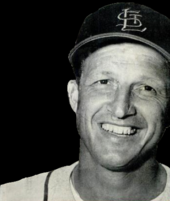
The Gashouse Gang edition claimed the 1934 World Series[22] and the Cardinals amassed new thresholds of popularity far outside St. Louis via radio, which led to the coining of the term "Cardinal Nation".[38] Dizzy Dean led the Gang, winning the 1934 MVP, and leading the NL multiple times in wins, strikeouts, innings, complete games and shutouts.[39] Johnny Mize and Joe Medwick emerged as two power threats, with Medwick claiming the last Triple Crown for a Cardinal in 1937.[28][22][40][41][42]
In the 1940s, a golden era emerged as Rickey's farm system became laden with such talent as Marty Marion,[43] Enos Slaughter,[44] Mort Cooper,[45] Walker Cooper,[46] Stan Musial,[47] Max Lanier,[48] Whitey Kurowski,[49] Red Schoendienst[50] and Johnny Beazley.[51] It was one of the most successful decades in franchise history with 960 wins and 580 losses for a winning percentage higher than any other Major League team at .623.[52] With Billy Southworth managing, they won the World Series in 1942 and 1944 (in the only all-St. Louis series against the Browns), and won 105 or more games each in 1942, 1943, and 1944.[7] Southworth's managerial winning percentage (.642) is St. Louis' highest since the franchise joined the National League.[53][54] Musial was considered the most consistent hitter of his era and most accomplished in team history, winning three MVPs and seven batting titles.[47][55] St. Louis then won the 1946 World Series on Slaughter's Mad Dash in Game 7.[56] Breadon was forced to sell the team in 1947 but won six World Series and nine NL pennants as Cardinals owner.[22] They remained competitive, finishing .500 or better in thirteen of the next seventeen seasons, but fell short of winning the league or World Series until 1964.[7]
Gussie Busch era (1953–1989)
[edit]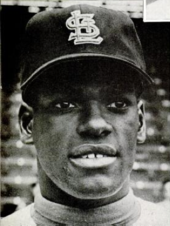
In 1953 the Anheuser-Busch brewery bought the Cardinals and August "Gussie" Busch became team president,[58] spurring the Browns' departure in 1953 to Baltimore to become the Orioles, and making the Cardinals the only major league club in town.[59] More success followed in the 1960s, starting with what is considered one of the most lopsided trades in Major League history, as St. Louis received outfielder Lou Brock from the Cubs for pitcher Ernie Broglio.[60] MVP third baseman Ken Boyer and pitcher Bob Gibson led the club to a World Series win the same year[61] and Curt Flood, Bill White, Curt Simmons, and Steve Carlton also made key contributions in this decade.[62][63][64][65] In 1967, new arrival Orlando Cepeda won the MVP, helping to propel St. Louis to the World Series.[66][67] The Cardinals won the league the following year behind their Major League-leading 2.49 staff ERA[68] in what was an all-round record-breaking season of pitching dominance. Posting a modern-day record low ERA of 1.12 and striking out a one-game World Series-record of 17,[69] Gibson won both the MVP and Cy Young awards that year.[70] However, the Cardinals failed to repeat as World Series champions, blowing a 3–1 lead to the underdog Detroit Tigers.
In the 1970s, catcher/third baseman Joe Torre and first baseman Keith Hernandez each won MVPs, but the team's best finishes were second place and 90 wins.[22][71][72] The team found their way back to the World Series three times in the 1980s, starting with manager Whitey Herzog and his Whiteyball style of play and another trade that altered course of the franchise: in 1982, shortstop Garry Templeton was shipped to the Padres for fellow shortstop Ozzie Smith.[73][74] Widely regarded as one of the best defensive players in history, Smith ranks first all-time among shortstops in Gold Glove Awards (13), All-Star games (15), assists (8,375), and double plays (1,590).[75][76] St. Louis won the 1982 World Series from the Milwaukee Brewers that fall.[77][78] The Cardinals again won the league in 1985 and 1987.[79] In the 1985 Series, they faced-off with cross-state rivals Kansas City Royals for the first time in a non-exhibition game, but they lost the series after a controversial call in Game 6;[80] the 1987 series saw them face off against the Minnesota Twins, but could only win all three of their games played at home in the seven-game series.
Bill DeWitt era (1996–present)
[edit]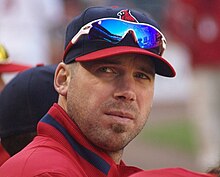
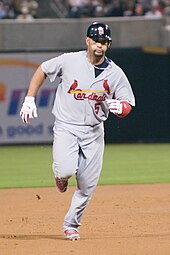
After Gussie Busch died in 1989,[82] the brewery took control[83] and hired Joe Torre to manage late in 1990,[84] then sold the team to an investment group led by William DeWitt Jr. in 1996.[85] Tony La Russa replaced Torre in the spring of 1996.[86] In 1998, Mark McGwire competed with the Cubs' Sammy Sosa for a barrage of home runs in their pursuit of the single-season home run record.[87] From 2000 to 2013, the Cardinals reestablished their way to the top with ten playoff appearances, four NL pennants, two World Series titles and 1,274 regular season wins against 993 losses for a .560 winning percentage, leading the National League and second in MLB only to the New York Yankees.[88] With the addition of Jim Edmonds, Albert Pujols, and Scott Rolen, the Cardinals featured three prominent sluggers and defenders nicknamed "MV3;"[89] Pujols won three MVPs and hit .328 with 445 home runs in his Cardinals career.[90] In 2004, playoff stalwart Chris Carpenter's 3.09 ERA and 15 wins[81] helped power the team to a major-league best 105 wins and take the NL pennant.[91] In 2006, beset with injuries and inconsistency,[92] they won the World Series, beating Detroit in five games to set an all-time record-low of 83 wins for a World Series winner.[93][22][94]
In 2009, the Cardinals reached 10,000 wins, dating to when they first played in the American Association (AA).[g][95][96] St. Louis returned to the playoffs in 2011, first surmounting the largest games-won deficit after 130 games (at 10.5) to upstage the Atlanta Braves on the final day for the wild card playoff berth.[97] In Game 3 of the World Series, Pujols became just the third player to hit three home runs in a World Series game.[98] In Game 6, third baseman David Freese and outfielder Lance Berkman each tied the score on the Cardinals' final strike—the first such occurrence in any game in MLB history—and St. Louis defeated the Texas Rangers later that game with a walk-off home run from Freese.[99] After winning that Series, La Russa retired and became the only manager to do so after winning a title. He also finished with the most wins for managers in franchise history with 1,408.[100][101]
La Russa's successor, Mike Matheny, helped extend St. Louis' playoff run as he became the first manager in the division play era to guide the Cardinals to the NLCS and playoffs in his first two seasons.[102] In 2014, the Cardinals extended their NLCS streak to 4, with their 3–1 series victory over the Dodgers, in the NLDS. Ten days after being eliminated from the postseason by the San Francisco Giants, rookie outfielder Oscar Taveras was killed in a car accident while traveling to his hometown Puerto Plata in the Dominican Republic.[103] On November 17, they acquired Atlanta Braves right-fielder Jason Heyward (who had just come off a Gold Glove-winning season) to replace Taveras.[104] On June 16, 2015, the FBI and the Justice Department started an investigation on the Cardinals for possibly hacking the Houston Astros. The hacking incident was perpetrated by Scouting Director Chris Correa.[105] For the first time since the 2007–2008 seasons, the Cardinals missed the playoffs in consecutive years, 2016–2017.
On July 14, 2018, following an 8–2 loss to the Cincinnati Reds, the St. Louis Cardinals announced they had dismissed manager Mike Matheny after 6+1⁄2 seasons. The team then named Mike Shildt interim manager, and he was made the permanent manager a month later.
On November 19, 2018, the team announced that the "Victory Blue" uniforms, worn by the Cardinals during the late 1970s and 1980s, would be returning for the 2019 season. The uniforms, integrating the powder blue color with the team's current "Saturday alternate" jersey design, were to be worn 13 times on the road during the 2019 season.[106] The Cardinals acquired Paul Goldschmidt in a trade from the Arizona Diamondbacks on December 5, 2018.[107]
On September 14, 2022, long-time starting pitcher Adam Wainwright and catcher Yadier Molina set the NL/AL record for most starts as pitcher and catcher duo, also referred to as a battery, at 325 starts together going back to 2007.[108] The previous record holding duo, Mickey Lolich and Bill Freehan, had held the record since 1975.[109]
Ballpark
[edit]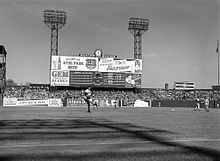
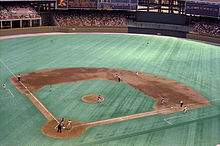
The Cardinals play their home games at Busch Stadium (also referred to as New Busch Stadium or Busch III) in downtown St. Louis, straddling 7th and Clark near the intersection of Interstates 64, 55, and 44.[110] The stadium opened for the 2006 season at a cost of $411 million and holds a normal capacity of 46,861.[111][112] The Cardinals finished their inaugural season in the new Busch Stadium by winning the 2006 World Series, the first team to do so since the New York Yankees in 1923.[113] This open-air stadium emulates the HOK Sport (now Populous)-designed "retro-style" baseball-only parks built since the 1990s.[114] The open panoramic perspective over the outfield wall offers a remarkable view of St. Louis' downtown skyline featuring the distinctive Gateway Arch.[115] A replica of the Eads Bridge spans the entrance to the park on the third base side, while the statue of Stan Musial stands in front of that entrance.[116] Other statues at the corner of 8th and Clark include Hall of Famers Rogers Hornsby, Ozzie Smith, George Sisler, Cool Papa Bell, Bob Gibson, Jack Buck, and others.[117]
Due to increased demand, Game 7 of the 2011 World Series accommodated a baseball record of 47,399 by increasing the number of standing room only tickets. The attendance record for any sporting event is 48,263, in a 2013 association football (soccer) friendly match between Chelsea F.C. and Manchester City F.C., made possible by on-field seating.[118] The largest attendance (53,000) of any event at Busch belongs to U2 during a concert from their 360° Tour in 2011.[119]
Ballpark Village is a mixed-use development located across Clark Street from Busch Stadium.[120] Phase 1 of the development, completed for the start of the 2014 season, includes entertainment venues, restaurants, and retail. Anchored by Cardinals Nation (which includes the Cardinals Hall of Fame, a two-story Cardinals-themed restaurant and rooftop seating for 300+ fans with views of the field across the street), a 20,000 sq ft (1,900 m2) Budweiser Brew House, FOX Sports Midwest Live! and PBR, the $100 million phase 1 development of Ballpark Village is intended to be a gathering space throughout the year, not just during the baseball season.[121]
Previous ballparks
[edit]Busch Stadium is the Cardinals' fourth home ballpark and the third to bear that name. The Cardinals' original home ballpark was Sportsman's Park from 1882 to 1892 when they played in the American Association and were known as the Browns. In 1893, the Browns moved to a new ballpark five blocks northwest of Sportsman's Park which would serve as their home from 1893 to 1920. The new park was originally called New Sportsman's Park but became more commonly referred to as Robison Field.[122] Midway through the 1920 season, the Cardinals abandoned Robison Field and returned to the original Sportsman's Park and became tenants of their American League rivals, the St. Louis Browns. In 1953, the Anheuser-Busch Brewery purchased the Cardinals and the new owner subsequently also purchased Sportsman's Park from the Browns and renamed it Busch Stadium, later becoming Busch I. The Browns then left St. Louis for Baltimore after the season, becoming the Orioles. The Cardinals built Busch Memorial Stadium, or Busch II, in downtown St. Louis, opened it during the 1966 season and played there until 2005.[122] It was built as the multi-purpose stadium home of both the baseball Cardinals and the NFL football Cardinals, who are now the Arizona Cardinals; the NFL's Rams also played the first four games of their home schedule upon their arrival in St. Louis in 1995. The current Busch Stadium was constructed partly atop the site of Busch Memorial Stadium.
Spring training
[edit]The Cardinals home field in spring training is Roger Dean Stadium in Jupiter, Florida. They share the complex, which opened in 1998, with the Miami Marlins. Before moving to Jupiter, the Cardinals hosted spring training at Al Lang Field in St. Petersburg, Florida from 1937 to 1997.
Regular season home attendance
[edit]
The Cardinals have exceeded the attendance total of 3 million every season from 2004 to 2019. Every season from 2013 to 2019, the Cardinals finished second among MLB franchises in home game attendance, surpassed only by the Los Angeles Dodgers each season. The Cardinals since 1987, have surpassed 3 million in 25 years, with the 25th season on September 18, 2023.[123]
| ||||||||||||||||||||||||||||||||||||||||||||||||||||||||||||||||||||||||||||||||||||||||||||||||||||||||||
Logos and uniforms
[edit]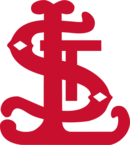
The Cardinals have had few logos throughout their history, although those logos have evolved over time. The first logo associated with the Cardinals was an interlocking "SL" that appeared on the team's caps and or sleeves as early as 1899 or 1900 (depending on the source). Those early uniforms usually featured the name "St. Louis" on white home and gray road uniforms which both had cardinal red accents. During an 1899 road trip to Chicago, a girl in the stands remarked, "Oh, isn't that a lovely shade of cardinal." The team, known as the Perfectos at the time, changed its name to Cardinals the following season. In 1920, the "SL" largely disappeared from the team's uniforms, and for the next 20 years the team wore caps that were white with red striping and a red bill.[125][126]
In 1922, the Cardinals wore uniforms for the first time that featured two cardinal birds perched on a baseball bat over the name "Cardinals" with the letter "C" of the word hooked over the bat. The concept of the birds originated after general manager Branch Rickey noticed a colorful cardboard arrangement featuring cardinal birds on a table in a Presbyterian church in Ferguson, Missouri, at which he was speaking. The arrangement's production was by a woman named Allie May Schmidt. Schmidt's father, a graphic designer, helped Rickey make the logo a familiar staple on Cardinals uniforms.[127] While the team had been known as the Cardinals for over 20 years by then, this logo changed the perception from the color to the bird.[126] The now-famous "birds on the bat" design initially appeared with the birds perched on a black bat and "Cardinals" in printed letters. An alternate version of this logo with "St. Louis" replacing "Cardinals" appeared in 1930 and was the primary logo in 1931 and 1932 before "Cardinals" returned. In 1940, the now-familiar "StL" logo was introduced on the team's caps. The interlocking "StL" has undergone several slight modifications over the years but has appeared on the team's caps every year since. The first appearance of the "STL" in 1940 coincided with the introduction of navy blue as a uniform color. From 1940 until 1955, the team wore navy blue caps with red bills and a red interlocking "StL" while the jerseys featured both cardinal red and navy blue accents. In 1951, the "birds on the bat" logo was changed to feature a yellow baseball bat.[128]
In 1956, the Cardinals changed their caps to solid blue with a red "StL", removing the red bill. Also, for that season only, the Cardinals wore a script "Cardinals" wordmark on their uniforms excluding the "birds on the bat". An updated version of the "birds on the bat" logo returned in 1957 with the word "Cardinals" written in cursive beneath the bat; this logo, with some incremental changes along the way, has been the team's logo since. In 1962, the Cardinals became the first National League team (and the second in all of Major League Baseball after the Chicago White Sox in 1960) to display players' names on the back of their jerseys. In 1964, while retaining their blue caps for road games, the Cardinals changed their home caps to all red with first a blue, than a white, interlocking "StL". The next year, the red caps were the only cap worn by the team full-time. In 1967, the birds on the bat emblem on the jersey was again tweaked, making the birds more realistic and changing the position of their tails relative to the bat and this version remained on all Cardinals game jerseys through 1997.
In 1971, following the trend in baseball at the time, the Cardinals replaced the traditional flannel front-button shirts and pants with belts with new pullover knit jerseys and beltless elastic waist pants. In 1973, the crew-neck collar became a V-neck. Another trend in baseball led the Cardinals to change their road uniforms from gray to light blue from 1976 to 1984; the player numbers were worn on the sleeves in 1979 and 1980. In 1992, the Cardinals returned to wearing traditional button-down shirts and pants with belts. That same year, they also brought back the all-navy cap with a red "StL", which were last worn in 1964, for use on the road only while wearing the same red and white cap for home games.
In 1998, the "birds on the bat" was updated for the first time in 30 years with more detailed birds and bolder letters. That year, St. Louis introduced a cap featuring a single cardinal bird perched on a bat worn for Sunday home games only. Up until 2020, the alternate "bird" caps were paired with their primary "StL" red batting helmets, but in the 2021 season, the Cardinals added a new helmet to match their home Sunday alternate caps. The new birds on the bat design was modified again the next year, with yellow beaks and white eyes replacing the red beaks and yellow eyes of the 1998 version. Uniform numbers also returned to the front of the jerseys in 1999 after a two-year absence.[128]
On November 16, 2012, the Cardinals unveiled a new alternate uniform to be worn at home games on Saturdays beginning with the 2013 season. The modified jersey, cream-colored with red trim on the sleeves and down the front, retains the "birds on the bat" but is the first since 1932 in which "St. Louis" is used instead of "Cardinals".[129] 2013 also saw the team adopt their red caps as their main cap for both home and away games for the first time since 1991; the navy cap was retained as an alternate, used when visiting other teams with red home caps.[128]
Starting with the 2019 season, the Cardinals have worn updated powder blue alternate uniforms during Saturday road games. Like the Saturday home cream alternates, it features red piping and "St. Louis" below the "birds on the bat" logo.[130] In 2020, the Cardinals introduced a slightly updated version of their "StL" cap logo, which was "soft launched" in 2019 via their social media accounts and game broadcasts.[131]
In 2023, the Cardinals introduced Stifel as its first uniform sponsor. The Stifel patch, which has red letters with the background color corresponding to the team's uniform, is placed on either sleeve depending on a player's handedness.[2]
In 2024, the Cardinals unveiled their City Connect uniform. The red-based uniform with white pants maintained the trademark "birds on the bat" logo in front, but with the script "The Lou" in white trimmed in navy blue instead of either the city or team name. "The Lou" paid homage to rapper Nelly, a St. Louis native who once coined the city's nickname on his 2000 single Country Grammar. Darker red wavy pinstripes were an allusion to the Mississippi River where St. Louis is situated. A red circular patch containing a yellow fleur-de-lis, a navy blue illustration of the Gateway Arch, and a red "STL" wordmark, is placed on either sleeve. Caps are red and featured the aforementioned "STL" wordmark in white with navy blue trim.[132]
Support
[edit]Fans
[edit]Mascots
[edit]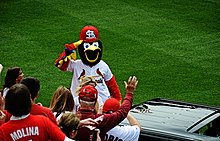
The team mascot is an anthropomorphic cardinal wearing the team's uniform named Fredbird. He is assisted by Team Fredbird, a group of eleven women who entertain fans from the field and on top of the dugouts.
While unofficial, the Rally Squirrel became an unexpected phenomenon during the 2011 postseason. Making its "debut" in Game 3 of the NLDS on October 4, a squirrel ran across home plate in the middle of a pitch from Roy Oswalt of the Phillies to the Cardinals' Skip Schumaker. The Cardinals would win Game 4 and subsequently Game 5 (October 7) in Philadelphia to advance to the NLCS, symbolizing the squirrel's "role" in the victory. The squirrel was popularized as "Buschie the Rally Squirrel".[133] As a tribute to the popularity of the squirrel, a small depiction of the Rally Squirrel is also included on the official World Series rings the team received. It shows up under the "STL" logo on the side of the ring.
Fredbird sparked controversy in May 2015, when he was asked by a fan for a photograph and handed him a sign that said "Police Lives Matter". The team later claimed that Fredbird should not be involved in any political activity or social commentary.[134]
Rivalries
[edit]Chicago Cubs
[edit]The Cardinals–Cubs rivalry refers to games between the Cardinals and the Chicago Cubs. The rivalry is also known as the Downstate Illinois rivalry or the I-55 Series (in earlier years as the Route 66 Series) as both cities are located along Interstate 55 (which itself succeeded the famous U.S. Route 66). The Cubs lead the series 1,253–1,196, through October 2021, while the Cardinals lead in National League pennants with 19 against the Cubs' 17. The Cubs have won 11 of those pennants in Major League Baseball's Modern Era (1901–present), while all 19 of the Cardinals' pennants have been won since 1926. The Cardinals also have an edge when it comes to World Series successes, having won 11 championships to the Cubs' 3. Games featuring the Cardinals and Cubs see numerous visiting fans in either Busch Stadium in St. Louis or Wrigley Field in Chicago.[135] When the National League split into two and then three divisions, the Cardinals and Cubs remained together. This has added excitement to several pennant races over the years. The Cardinals and Cubs have played each other once in the postseason, 2015 National League Division Series, which the Cubs won 3–1.
Kansas City Royals
[edit]The Cardinals have an interleague and intrastate rivalry with the Kansas City Royals, dubbed the "Show-Me Series" after the nickname of the team's home state, Missouri; or the "I–70 Series" after the interstate highway that connects the cities. The teams first met in the 1985 World Series, which the Royals won 4–3, and which remains their only post-season meeting.
Since interleague play began in 1997, the Cardinals and Royals have met in four to six games each season, evenly split between the two cities. As of 2021, the Cardinals lead the overall series 71–50.
The rivalry heated up in 2015, when both teams held the best records in their respective leagues when they opened each of their two series. The Royals advanced to the World Series, where they faced and ultimately defeated the New York Mets, while the Cardinals lost in the NLDS. Had the Cardinals made it to the World Series, they would have faced the Royals in a rematch of 1985.
Los Angeles Dodgers
[edit]Primarily a playoff rivalry; since 1892, the Cardinals and Dodgers have met six times in the postseason, with two meetings in the NLCS, both won by the Cardinals. Both teams have recently grown a history of animosity towards one another since the late 2000s as both teams often met frequently in the postseason. The Dodgers have not fared as well against the Cardinals in the postseason. In five prior postseason series matchups, the Cardinals have won four, with the Dodgers winning only the 2009 NLDS and the 2021 National League Wild Card Game.[136][137]
New York Mets
[edit]The rivalry between the Cardinals and the New York Mets peaked during the 1980s when both teams contended for National League East supremacy. The rivalry began with the 1983 trade that brought Keith Hernandez from the Cardinals to the Mets, essentially turning the latter into contenders.[138] Between 1985 and 1988, the division was dominated by either of the two teams, and in three of those years, the NL East winner went on to the World Series. In 1994, the Cardinals were moved to the National League Central, and the rivalry faded soon after. The two teams would meet in the 2000 and 2006 National League Championship Series, briefly rekindling the rivalry.[139][140][141][142]
Executives and club officials
[edit]Ownership and valuation
[edit]An investment group led by William DeWitt Jr. owns the St. Louis Cardinals, having bought the team from Anheuser-Busch (AB) in 1996.[143] As with other periods of the Cardinals' transaction history, doubt loomed as to whether the purchaser would keep the team in St. Louis, due to the city's status as a "small market", which appears to handicap a club's competitiveness. Such was the case when Sam Breadon put the Cardinals up for sale in 1947: then-NL President Ford Frick proposed moving the Cardinals to Chicago.[144] When AB placed the Cardinals for sale in 1995, they publicly expressed intention to find a buyer who would keep the club in St. Louis.[145] In March 1996, AB sold the team for $147 million to a partnership headed by Southwest Bank's Drew Baur, Hanser and DeWitt Jr.[144] Civic Center Redevelopment, a subsidiary of AB, held the parking garages and adjacent property and also transferred them to the Baur ownership group.[146] Baur's group then sold the garages to another investment group, lowering the net franchise purchase price to about $100 million, about $10 million less than Financial World's value of the team at the time $110 million.[145][147]
Current Cincinnati Reds owners Bob Castellini and brothers Thomas Williams and W. Joseph Williams Jr. each once owned a stake in the Cardinals dating back to the Baur-DeWitt group's purchase of the team. To allow their purchase of the Reds in 2005, the rest of the group bought out Castellini's and the Williams brothers' shares, totaling an estimated 13 percent. At that time, the Forbes valued the Cardinals at about $370 million.[148] However, after reabsorbing that stake into the remainder of the group, they decided to make it available to new investors in 2010. Amid later allegations that the Cardinals owed the city profit shares, DeWitt revealed that their profitability had not reached the threshold to trigger that obligation.[149]
Recent annual financial records
[edit]As of 2024, Forbes valued the Cardinals tenth among the 30 MLB franchises. Their estimated value of $2.55 billion was the same from the season before, when they ranked tenth. St. Louis' revenue in 2024 was $372 million, up $14 million from 2023. Their Operating income was $57 million.[150] The Cardinals' deal with Fox Sports Midwest (now Bally Sports Midwest), signed in 2015, began in 2018, and is worth $1 billion through 2032.[151][10][11][152][153][154] In 2014, Forbes valued the Cardinals at $820 million and opined previously that they play "in the best single-team baseball market in the country and are among the league's leaders in television ratings and attendance every season."[154] Concurrent with the growth of Major League Baseball, the Cardinals value has increased significantly since the Baur-DeWitt purchase. In 2000, the franchise was valued at $219 million,[155] a growth rate of 374% through 2014. The franchise's value grew 12.7% from 2013 to 2014. The Forbes methodology of team values are enterprise values (equity plus net debt) that include the economics of the ballpark but exclude the value of real estate itself. Forbes does not include the value of team-owned regional sports networks. The league's ownership in Major League Baseball Advanced Media (100%) and the MLB Network (67%) and league's investment portfolio are included in our values. In total, these three assets constitute about $425 million in value for each team. Revenue and operating income (earnings before interest, taxes, depreciation and amortization) measure cash in versus cash out (not accrual accounting) for the 2017 season. Their figures include the post-season and are net of revenue sharing and stadium debt payments. Revenues include the pro-rated upfront bonuses networks pay teams as well as proceeds from non-MLB events at the ballpark. The non-recurring $18 million each team received in 2017 from the sale of a stake in BamTech to Walt Disney was excluded, as were profits or losses from team-owned RSNs.[156]
| St. Louis Cardinals' financial value since 2009 | ||||||
| Year | $ Value (mil.)1 | $ Revenue (mil.) 2 | $ Operating Income (mil.) 3 | $ Player Expenses (mil.) 4 | Win-to-Player Cost Ratio 5 | Ref |
| 2009 | $486 | $195 | $ 7 | $120 | 87 | |
| 2010 | $488 | $195 | $12.8 | $111 | 100 | [157] |
| 2011 | $518 | $207 | $19.8 | $110 | 94 | [158] |
| 2012 | $591 | $233 | $25.0 | $123 | 116 | [159] |
| 2013 | $716 | $239 | $19.9 | $134 | 102 | [154] |
| 2014 | $820 | $283 | $65.2 | $133 | 118 | [153][160] |
| 2015 | $1,400 | $294 | $73.6 | $133 | 111 | [160][161] |
| 2016 | $1,600 | $300 | $59.8 | $145 | 115 | [10] |
| 2017 | $1,800 | $310 | $41 | $173 | 86 | [162] |
| 2018 | $1,900 | $319 | $40 | $165 | 89 | [9] |
| 2019 | $2,100 | $356 | $65 | $176 | 90 | [9] |
| 2020 | $2,200 | $383 | $72 | $182 | 95 | [9] |
| 2021 | $2,200 | $109 | -$79 | $88 | 76 | [9] |
| 2022 | $2,500 | $287 | -$34 | $191 | 78 | [9] |
| 2023 | $2,600 | $358 | $43 | $174 | 100 | [9] |
| 2024 | $2,600 | $372 | $57 | $169 | 85 | [150] |
All valuations per Forbes.
1 Based on current stadium deal (unless new stadium is pending) without deduction for debt, other than stadium debt.
(2024: market $1,070 mil., stadium $540 mil., sport $590 mil., brand management $350 mil.)[150]
(2018: market $715 mil., stadium $447 mil., sport $493 mil., brand management $245 mil.)[9]
(2017: market $666 mil., stadium $411 mil., sport $488 mil., brand management $235 mil.)[162]
(2016: market $613 mil., stadium $378 mil., sport $406 mil., brand management $219 mil.)[10]
(2015: market $548 mil., stadium $338 mil., sport $331 mil., brand management $197 mil.)
(2014: market $339 mil., stadium $211 mil., sport $156 mil., brand management $124 mil.)
(2013: market $291 mil., stadium $182 mil., sport $151 mil., brand management $91 mil.)
(2012: market $240 mil., stadium $157 mil., sport $119 mil., brand management $78 mil.)
(2011: market $206 mil., stadium $136 mil., sport $111 mil., brand management $65 mil.)
2 Net of stadium revenues used for debt payments.
3 Earnings before interest, taxes, depreciation and amortization.
4 Includes benefits and bonuses.
5 Compares the number of wins per player payroll relative to the rest of MLB. Playoff wins count twice as much as regular season wins. A score of 120 means that the team achieved 20% more victories per dollar of payroll compared with the league average in 2010.
Other interests
[edit]The Cardinals own three of their six Minor League Baseball affiliates:
- Palm Beach Cardinals, Florida State League[163]
- FCL Cardinals, Florida Complex League[163]
- DSL Cardinals, Dominican Summer League[163]
Executives
[edit]- Franchise Principals[12]
- Chairman & CEO: William DeWitt Jr.
- President: Bill DeWitt III
- Sr. Vice President & General Counsel: Mike Whittle
- Vice President, Business Development: Dan Good
- Baseball Operations[12]
- President of Baseball Operations: John Mozeliak
- Vice President & General Manager: Mike Girsch
- Assistant General Manager: Moisés Rodríguez
- Assistant General Manager & Director of Scouting: Randy Flores
- Assistant General Manager & Director of Player Development and Performance: Rob Cerfolio
- Advisor to President, Baseball Operations: Chaim Bloom
- Special Assistant to GM / Player Procurement: Matt Slater
- Special Assistant to President, Baseball Operations: Joe McEwing
- Special Assistant to President, Baseball Operations: Willie McGee
- Special Assistant to President, Baseball Operations: Yadier Molina
- Director, Baseball Administration: John Vuch
- Advisor: Gary LaRocque
- Baseball Analytics[12]
- Sr. Director of Baseball Development: Jeremy Cohen
- Baseball Systems[12]
- Senior Lead Application Developer: Brian Seyfert
- Travel & Clubhouse[12]
- Director, Team Travel: Ernie Moore
- Performance & Medical[12]
- Director of Medical Operations / Head Athletic Trainer: Adam Olsen
- Communications[12]
- Sr. Director, Communications: Brian Bartow
- Cardinals Care & Community Relations[12]
- Vice President, Community Relations & Exec. Director, Cardinals Care: Michael Hall
- Event Services and Merchandising[12]
- Vice President, Event Services & Merchandising: Vicki Bryant
- Finance and Administration[12]
- Sr. Vice President & CFO: Brad Wood
- Stadium Operations[12]
- Vice President, Stadium Operations: Matt Gifford
- Ticket Sales, Marketing & Corporate Sales[12]
- Sr. Vice President, Business Operations: Anuk Karunaratne
- Business Analytics & Information Technology[12]
- Vice President, Business Strategy & Analytics: Mark Murray
- Corporate Sales & Broadcasting[12]
- Vice President, Corporate Sales & Broadcasting: Thane vanBreusegen
- Content & Production[12]
- Sr. Director, Content & Production: Tony Simokaitis
- Marketing & Brand Execution[12]
- Sr. Director, Marketing & Brand Management: Martin Coco
- Publications[12]
- Sr. Director, Publications: Steve Zesch
- Ticket Sales[12]
- Vice President, Ticket Sales: Joe Strohm
Managers
[edit]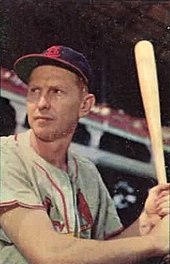
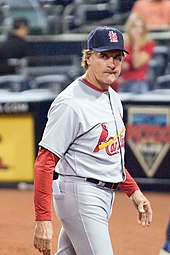
Field managers with one or more years managing, and the current manager are included here.[7]
| Dates | Name | W-L Record | % | Highlights | Ref |
|---|---|---|---|---|---|
| 1883–89, 1891 | Charlie Comiskey† | 563–273 | .673* | Highest winning-percentage in franchise history; Four consecutive World Series appearances, one title |
[24] |
| 1895, 96, 97 | Chris von der Ahe | 3–14 | .176 | [164] | |
| 1901–03 | Patsy Donovan | 175–236 | .426 | [165] | |
| 1904–05 | Kid Nichols† | 80–88 | .476 | [166] | |
| 1906–08 | John McCloskey | 153–304 | .335 | [167] | |
| 1909–12 | Roger Bresnahan† | 255–352 | .420 | [168] | |
| 1913–17 | Miller Huggins† | 346–415 | .455 | [169] | |
| 1918 | Jack Hendricks | 51–78 | .395 | [170] | |
| 1919–25 | Branch Rickey† | 458–485 | .486 | [171] | |
| 1925–26 | Rogers Hornsby† | 153–116 | .569 | One World Series win (player-manager) | [172] |
| 1927 | Bob O'Farrell | 92–61 | .601 | [173] | |
| 1928–29 | Bill McKechnie† | 129–88 | .594 | One NL pennant | [174] |
| 1929, 1940–45 | Billy Southworth† | 620–346 | .642** | Second-highest winning-percentage in franchise history (highest modern); Two World Series (1942, 1944) wins |
[54] |
| 1929, 1930–33 | Gabby Street | 312–242 | .563 | Two NL pennants and one World Series win | [175] |
| 1933–38 | Frankie Frisch† | 458–354 | .564 | One World Series win | [176] |
| 1939–40 | Ray Blades | 106–85 | .555 | [177] | |
| 1946–50 | Eddie Dyer | 446–325 | .578 | One World Series win | [178] |
| 1951 | Marty Marion | 81–73 | .526 | [179] | |
| 1952–55 | Eddie Stanky | 260–238 | .522 | [180] | |
| 1956–58 | Fred Hutchinson | 232–220 | .513 | [181] | |
| 1959–61 | Solly Hemus | 190–192 | .497 | [182] | |
| 1961–64 | Johnny Keane | 317–249 | .560 | One World Series win | [183] |
| 1965–76, 1980, 1990 | Red Schoendienst† | 1041–955 | .522 | Two NL pennants and one World Series win | [184] |
| 1977–78 | Vern Rapp | 89–90 | .497 | [185] | |
| 1978–80 | Ken Boyer | 166–190 | .466 | [186] | |
| 1980–90 | Whitey Herzog† | 822–728 | .530 | Three NL pennants and one World Series win | [74] |
| 1990–95 | Joe Torre† | 351–354 | .498 | [84] | |
| 1996–2011 | Tony La Russa† | 1408*–1182* | .544 | Most managerial wins and seasons (16) in team history; Two World Series (2006, 2011) wins |
[187] |
| 2012–18 | Mike Matheny | 591–474 | .555 | One NL pennant | [188] |
| 2018–21 | Mike Shildt | 252–199 | .559 | [189] | |
| 2022–present | Oliver Marmol | 164–160 | .506 | [190] |
- Table key
- *All-time franchise leader. ** Franchise leader since 1900.
W-L |
Total number of wins and losses |
WPct |
Winning percentage: Number of wins divided by total of wins and losses |
Bold |
Franchise leader |
† |
Elected to the National Baseball Hall of Fame |
Players
[edit]Current roster
[edit]| 40-man roster | Non-roster invitees | Coaches/Other | ||||
|---|---|---|---|---|---|---|
|
Pitchers
|
Catchers
Infielders
Outfielders
|
|
Manager Coaches
38 active, 0 inactive, 0 non-roster invitees
| |||
Coaching staff
[edit]Selected individual achievements and awards
[edit]- Darryl Kile Award: Two awards are presented each year, one to a St. Louis Cardinal and one to a Houston Astro, each of whom exemplifies Kile's virtues of being "a good teammate, a great friend, a fine father and a humble man." The winner is selected by each local chapter of the Baseball Writers' Association of America.[191] See: St. Louis Cardinals award winners and league leaders § Darryl Kile Good Guy Award.
- No-hitters: Cardinal pitchers have thrown 10 no-hitters: Ted Breitenstein (1891), Jesse Haines (1924), Paul Dean (1934), Lon Warneke (1941), Ray Washburn (1968), Bob Gibson (1971), Bob Forsch (1978 and 1983), José Jiménez (1999), and Bud Smith (2001). The Cardinals have never been involved in a perfect game, win or lose.
- Cy Young Awards: Two Cardinal pitchers have won Cy Young Awards: Bob Gibson in 1968 and 1970, and Chris Carpenter in 2005.[192]
- MVP Awards: 17 different Cardinal players have won a total of 21 Most Valuable Player awards, the most recent being Paul Goldschmidt in 2022. Albert Pujols and Stan Musial have collected the most MVPs with three apiece. Bob Gibson won both the Cy Young Award and the MVP award in 1968.[192] The Cardinals are second only to the New York Yankees' 22 MVP awards.[193]
- Rookie of the Year: Six Cardinals have won the Rookie of the Year award: Wally Moon in 1954, Bill Virdon in 1955, Bake McBride in 1974, Vince Coleman in 1985, Todd Worrell in 1986, and Albert Pujols in 2001.
- Hitting for the cycle: 19 different Cardinal players have hit for the cycle for a total of 21 times, the most recent being Nolan Arenado in 2022.[194]
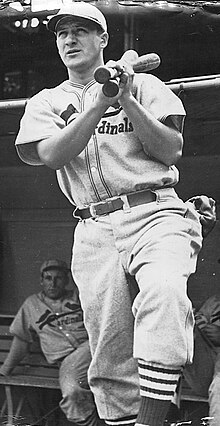
- Triple Crown: Four of the 16 batting Triple Crowns in the major leagues (including three of only six in the National League) were by Cardinals. Tip O'Neill won the only American Association Triple Crown and the first in franchise history in 1887. Rogers Hornsby became the only two-time winner in NL history when he did it in 1922 and 1925 (Ted Williams won two AL Triple Crowns). Joe Medwick's Triple Crown in 1937 is the last in the history of the National League.[195] Hornsby's 1925 numbers led the entire major leagues, making him one of only five players to have won this expanded Triple Crown.
- Home runs and RBI in a game: Jim Bottomley drove in 12 runs against the Brooklyn Robins on September 16, 1924, an all-time MLB single-game record that still stands.[196][197] On September 7, 1993, Mark Whiten tied that record and another MLB single-game record with four home runs.[198][199]
- Four home runs in a row by consecutive batters: Nolan Arenado, Nolan Gorman, Juan Yepez, and Dylan Carlson hit consecutive home runs on July 2, 2022, off starting pitcher Kyle Gibson of the Phillies. This feat has only occurred eleven times in the history of Major League Baseball.[200]
- Two grand slams in a single inning: Fernando Tatís is the only player in Major League history to hit two grand slam home runs in the same inning, on April 23, 1999. Both were against Chan Ho Park of the Dodgers.[201]
Team captains
[edit]- Leo Durocher 1934–1937
- Terry Moore 1942–1948
- Ken Boyer 1959–1965
- Ted Simmons and Reggie Smith 1976[202]
Hall of Famers
[edit]Inducted into the National Baseball Hall of Fame and Museum
[edit]St. Louis Cardinals Hall of Fame and Museum
[edit]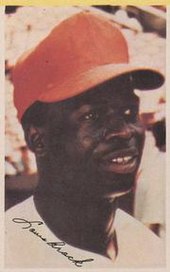
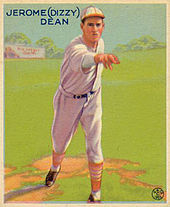
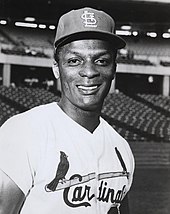
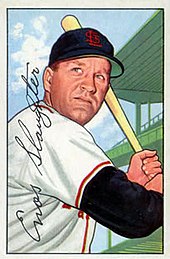
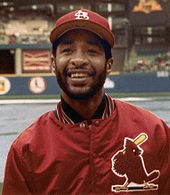
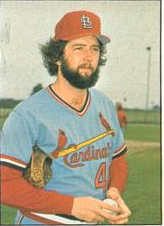
In 2014, the Cardinals announced the reopening of the franchise Hall of Fame after a 6-year hiatus. A formal selection process recognizes former players as Cardinals Hall of Famers each year. To be eligible for election, a player must have been a member of the Cardinals for at least three seasons. The team initially released the names of 22 former players and personnel included in the inaugural class of 2014.[203] There are now 55 members of the Cardinals Hall of Fame.
| Bold | Member of the Baseball Hall of Fame |
|---|---|
†
|
Member of the Baseball Hall of Fame as a Cardinal |
| Bold | Recipient of the Hall of Fame's Ford C. Frick Award |
Positions that are listed were played the equivalent of a full season for the Cardinals.
| No. | Name | Years with Cardinals Franchise | Position(s) | Year Elected | Committee Selection |
|---|---|---|---|---|---|
| 4 | Jim Bottomley† | 1922–1932 | 1B | 2014 | Inaugural |
| 14 | Ken Boyer | 1955–1965, 1971–1972, 1978–1980 | 3B, CF, Manager, Coach | 2014 | Inaugural |
| — | Sam Breadon | 1917–1947 | Owner | 2016 | Team |
| 31 | Harry Brecheen | 1940, 1943–1952 | P | 2018 | Red Ribbon |
| 20 | Lou Brock† | 1964–1979 | LF | 2014 | Inaugural |
| — | Jack Buck | 1954–1959, 1961–2001 | Broadcaster | 2014 | Inaugural |
| 85 | Gussie Busch | 1953–1989 | Owner | 2014 | Inaugural |
| 29 | Chris Carpenter | 2004–2012 | P | 2016 | Fan |
| 29 | Vince Coleman | 1985–1990 | LF | 2018 | Fan |
| — | Charles Comiskey | 1882–1889, 1891 | 1B, Manager | 2022 | Team |
| 13, 14, 24, 25, 30 | Mort Cooper | 1938–1945 | P | 2019 | Red Ribbon |
| 17 | Dizzy Dean† | 1930, 1932–1937, 1941–1946 | P, Broadcaster | 2014 | Inaugural |
| 18 | Dave Duncan | 1996–2011 | Coach | 2024 | Team |
| 15 | Jim Edmonds | 2000–2007, 2016–present | CF, Broadcaster | 2014 | Fan |
| 21, 42 | Curt Flood | 1958–1969 | CF | 2015 | Red Ribbon |
| 31, 37 | Bob Forsch | 1974–1988 | P | 2015 | Fan |
| 3 | Frankie Frisch† | 1927–1938 | 2B, 3B, Manager | 2014 | Inaugural |
| 31, 45, 58 | Bob Gibson† | 1959–1975, 1995 | P, Coach | 2014 | Inaugural |
| — | Chick Hafey† | 1924–1931 | OF | 2014 | Inaugural |
| 16 | Jesse Haines† | 1920–1937 | P | 2014 | Inaugural |
| 18, 37 | Keith Hernandez | 1974–1983 | 1B | 2021 | Fan |
| 28 | Tom Herr | 1979–1988 | 2B | 2020 | Fan |
| 24 | Whitey Herzog† | 1980–1990 | Manager, General Manager | 2014 | Inaugural |
| 7, 15 | Matt Holliday | 2009–2016 | LF | 2022 | Fan |
| 4 | Rogers Hornsby† | 1915–1926, 1933 | 2B, 3B, SS, Manager | 2014 | Inaugural |
| 44 | Jason Isringhausen | 2002–2008 | P | 2019 | Fan |
| 25 | Julián Javier | 1960–1971 | 2B | 2022 | Red Ribbon |
| 3 | George Kissell | 1940–1942, 1946–2008 | Coach, Instructor, Scout | 2015 | Team |
| 1, 5 | Whitey Kurowski | 1941–1949 | 3B | 2024 | Red Ribbon |
| 21, 23, 30, 32, 40 | Max Lanier | 1938–1946, 1949–1951 | P | 2023 | Red Ribbon |
| 12, 16 | Ray Lankford | 1990–2001, 2004 | CF | 2018 | Fan |
| 10 | Tony La Russa† | 1996–2011 | Manager | 2014 | Inaugural |
| 4 | Marty Marion | 1940–1951 | SS, Manager, Coach | 2014 | Red Ribbon |
| 1, 2, 10, 11, 28 | Pepper Martin | 1928, 1930–1940, 1944 | 3B, OF | 2017 | Red Ribbon |
| 9, 15, 20, 51 | Tim McCarver | 1959–1969, 1973–1974, 2014–2019 | C, 1B, Broadcaster | 2017 | Fan |
| 51 | Willie McGee | 1982–1990, 1996–1999, 2018–present | OF, Coach | 2014 | Fan |
| 25 | Mark McGwire | 1997–2001, 2010–2012 | 1B, Coach | 2017 | Fan |
| 7, 12, 21, 28 | Joe Medwick† | 1932–1940, 1947–1948 | LF | 2014 | Inaugural |
| 10 | Johnny Mize† | 1936–1941 | 1B | 2014 | Inaugural |
| 2, 8, 11 | Terry Moore | 1935–1942, 1946–1952, 1956–1958 | CF, Coach | 2016 | Red Ribbon |
| 35 | Matt Morris | 1997–2005 | P | 2024 | Fan |
| 6 | Stan Musial† | 1941–1944, 1946–1963, 1967 | 1B, OF, General Manager | 2014 | Inaugural |
| 5, 11, 91 | José Oquendo | 1986–1995, 1997–2015, 2017–present | 2B, SS, Coach | 2023 | Team |
| — | Branch Rickey | 1919–1942 | Manager, General Manager, President | 2014 | Inaugural |
| 16, 27 | Scott Rolen | 2002–2007 | 3B | 2019 | Fan |
| 2, 6 | Red Schoendienst† | 1945–1956, 1961–1976, 1979–1995 | 2B, LF, Manager, Coach | 2014 | Inaugural |
| 18, 28 | Mike Shannon | 1962–1970, 1972–2021 | 3B, RF, Broadcaster | 2014 | Team |
| 23 | Ted Simmons† | 1968–1980 | C, 1B | 2015 | Fan |
| 9 | Enos Slaughter† | 1938–1942, 1946–1953 | RF | 2014 | Inaugural |
| 1 | Ozzie Smith† | 1982–1999 | SS, Broadcaster | 2014 | Inaugural |
| — | Billy Southworth† | 1926–1927, 1929, 1940–1945 | RF, Manager | 2014 | Inaugural |
| 42 | Bruce Sutter | 1981–1984 | P | 2014 | Inaugural |
| 9, 22 | Joe Torre | 1969–1974, 1990–1995 | C, 1B, 3B, Manager | 2016 | Fan |
| 30, 48 | John Tudor | 1985–1988, 1990 | P | 2020 | Fan |
| 7, 12, 26 | Bill White | 1959–1965, 1969 | 1B, OF | 2020 | Red Ribbon |
Players who have been nominated, but not inducted, include Joaquín Andújar, Steve Carlton, George Hendrick, Édgar Rentería, and Lee Smith.[204]
After receiving the most fan votes on the 2023 ballot, David Freese later declined his induction into the Cardinals Hall of Fame.[205]
Inducted into the Missouri Sports Hall of Fame
[edit]| St. Louis Cardinals in the Missouri Sports Hall of Fame | |||||
| No. | Name | Years with Cardinals Franchise | Position(s) | Year Elected | Notes |
|---|---|---|---|---|---|
| — | Lou Adamie | 1941–1982 | Scorekeeper | 2007 | |
| — | Jack Buck | 1954–1959, 1961–2001 | Broadcaster | 1980 | |
| — | Bing Devine | 1957–1964, 1967–1978 | GM | 1996 | Born and raised in St. Louis |
| — | Charlie Grimm | 1918 | 1B | 1966 | Born in St. Louis |
| — | Walt Jocketty | 1994–2007 | GM | 2007 | |
| — | Mark Lamping | 1994–2008 | President | 2021 | Attended Rockhurst University in Kansas City, MO |
| — | Branch Rickey | 1919–1942 | Manager, GM, President | 1965 | |
| 1 | Ozzie Smith | 1982–1999 | SS, Broadcaster | 1997 | |
| 2, 6 | Red Schoendienst | 1945–1956, 1961–1976, 1979–1995 | 2B, LF, Manager, Coach | 1987 | |
| 2, 8, 11 | Terry Moore | 1935–1942, 1946–1952, 1956–1958 | CF, Coach | 1992 | |
| 3 | Frankie Frisch | 1927–1938 | 2B, 3B, Manager | 1972 | |
| 3 | George Kissell | 1940–1942, 1946–2008 | Coach, Instructor, Scout | 2003 | |
| 4, 6 | Rogers Hornsby | 1915–1926, 1933 | 2B, SS, 3B, Manager | 1972 | |
| 4 | Marty Marion | 1940–1951 | SS, Manager, Coach | 1992 | |
| 5, 22 | Don Gutteridge | 1936–1940 | 2B, 3B, SS | 2001 | |
| 6 | Stan Musial | 1941–1944, 1946–1963, 1967 | OF, 1B, GM | 1963 | |
| 7, 12, 21, 28 | Joe Medwick | 1932–1940, 1947–1948 | LF | 2019 | |
| 7, 15 | Matt Holliday | 2009–2016 | LF | 2022 | |
| 8 | Hal McRae | 2005–2009 | Coach | 2004 | Elected mainly on his performance with the Kansas City Royals |
| 8, 14 | Mickey Owen | 1937–1940 | C | 2012 | Born and raised in Nixa, MO |
| 9 | Roger Maris | 1967–1968 | RF | 2013 | |
| 9 | Terry Pendleton | 1984–1990 | 3B | 2020 | |
| 9 | Enos Slaughter | 1938–1942, 1946–1953 | RF | 1999 | |
| 9 | Bill Virdon | 1955–1956 | CF | 1983 | Grew up in West Plains, MO, attended Drury University in Springfield, MO |
| 9, 15, 20, 51 | Tim McCarver | 1959–1969, 1973–1974, 2014–2019 | C, 1B, Broadcaster | 2004 | |
| 10 | Tony La Russa | 1996–2011 | Manager | 2006 | |
| 14 | Ken Boyer | 1955–1965, 1971–1972, 1978–1980 | 3B, CF, Manager, Coach | 1992 | Born in Liberty, MO, grew up in Alba, MO |
| 15 | Jim Edmonds | 2000–2007, 2016–present | CF, Broadcaster | 2012 | |
| 15 | Darrell Porter | 1981–1985 | C | 2000 | Born in Joplin, MO |
| 15, 28 | Joe Cunningham | 1954, 1956–1961 | 1B, RF | 2012 | |
| 16 | Jamie Quirk | 1983 | C, 3B | 2012 | Elected mainly on his performance with the Kansas City Royals |
| 17 | Dizzy Dean | 1930, 1932–1937, 1941–1946 | P, Broadcaster | 1970 | |
| 17 | Joe Garagiola | 1946–1951, 1955–1962 | C, Broadcaster | 1970 | |
| 18 | Dave Duncan | 1996–2011 | Coach | 2014 | |
| 18 | Andy Van Slyke | 1983–1986 | CF, 1B, 3B | 2021 | |
| 18, 28 | Mike Shannon | 1962–1970, 1972–2021 | 3B, RF, Broadcaster | 1999 | |
| 18, 37 | Keith Hernandez | 1974–1983 | 1B | 2008 | |
| 19 | Tom Pagnozzi | 1987–1998 | C, 1B | 2010 | |
| 19 | Preacher Roe | 1938 | P | 1998 | |
| 20 | Lou Brock | 1964–1979 | LF | 1998 | |
| 21, 42 | Curt Flood | 1958–1969 | CF | 2013 | |
| 22 | David Eckstein | 2005–2007 | SS, 2B | 2013 | |
| 22, 44 | Mike Matheny | 2000–2004, 2012–2018 | C, Manager | 2011 | |
| 23 | Bernard Gilkey | 1990–1995 | LF | 2018 | |
| 23 | Charlie James | 1960–1964 | OF | 2015 | Born in St. Louis, attended the University of Missouri in Columbia, MO |
| 23 | Ted Simmons | 1968–1980 | C, 1B | 2005 | |
| 24 | Dick Groat | 1963–1965 | SS | 2012 | |
| 24 | Whitey Herzog | 1980–1990 | Manager, GM | 1994 | |
| 24, 49, 66 | Rick Ankiel | 1999–2001, 2004, 2007–2009 | CF, P | 2018 | |
| 25 | Gabby Street | 1929–1933 | C, Manager | 1966 | |
| 28 | Tom Herr | 1979–1988 | 2B | 2011 | |
| 28, 30 | Orlando Cepeda | 1966–1968 | 1B, LF | 2000 | |
| 28, 40 | Dan Quisenberry | 1988–1989 | P | 1997 | Elected mainly on his performance with the Kansas City Royals |
| 29 | Chris Carpenter | 2004–2012 | P | 2013 | |
| 29 | Vince Coleman | 1985–1990 | LF | 2017 | |
| 31, 37 | Bob Forsch | 1974–1988 | P | 2002 | |
| 31, 40, 41 | Alan Benes | 1995–2001 | P | 2020 | |
| 31, 45, 58 | Bob Gibson | 1959–1975, 1995 | P, Coach | 1996 | |
| 32, 34 | Mark Littell | 1978–1982 | P | 2016 | |
| 33, 44, 47 | Ken Reitz | 1972–1975, 1977–1980 | 3B | 2009 | |
| 34 | Danny Cox | 1983–1988 | P | 2022 | |
| 34, 51 | Darold Knowles | 1979–1980 | P | 2012 | Born and raised in Brunswick, MO, attended the University of Missouri in Columbia, MO |
| 37 | Dennis Higgins | 1971–1972 | P | 2013 | |
| 37 | Jeff Suppan | 2004–2006, 2010 | P | 2019 | |
| 38 | Todd Worrell | 1985–1989, 1992 | P | 2009 | |
| 39 | Al Hrabosky | 1970–1977 | P | 2003 | |
| 40 | Andy Benes | 1996–1997, 2000–2002 | P | 2020 | |
| 40 | Rick Sutcliffe | 1994 | P | 2004 | Born and raised in Independence, MO |
| 42 | Bruce Sutter | 1981–1984 | P | 2007 | |
| 44 | Jason Isringhausen | 2002–2008 | P | 2016 | |
| 47 | Lee Smith | 1990–1993 | P | 2018 | |
| 49 | Ricky Horton | 1984–1987, 1989–1990 | P | 2014 | |
| 49 | Jerry Reuss | 1969–1971 | P | 2016 | Born in St. Louis, grew up in Overland, MO |
| 50 | Tom Henke | 1995 | P | 2000 | Born and raised in Kansas City, MO |
| 50 | Lee Thomas | 1970–1988 | Coach, Instructor | 2008 | |
| 51 | Willie McGee | 1982–1990, 1996–1999, 2018–present | OF, Coach | 2014 | |
| 85 | Gussie Busch | 1953–1989 | Owner | 1975 | Born and raised in St. Louis |
Retired numbers
[edit]The Cardinals have retired 13 total jersey numbers––second in MLB only to the New York Yankees' 22––in honoring 15 total former players and club personnel on the left field wall at Busch Stadium.[206][207] A 16th, Jackie Robinson, is honored by all MLB teams.[208] For the majority of Rogers Hornsby's career, the Cardinals did not have any numbers on their uniforms. When the Cardinals experimented with numbers on uniforms in 1923, Hornsby briefly donned the number 4. He switched to 6 the following season before the team abandoned the practice. Upon his return to the team in 1933, Hornsby again wore number 4 before being traded later that year. The club opted to simply honor his name with no number attached to him in 1997.
|
Notes:
- Hornsby: When honored in 1997, '"SL"' was used in place of a number as he played mostly in an era without numbers.[209]
- 42: Jackie Robinson's number 42 was retired throughout baseball in 1997. The Cardinals again retired 42 in September 2006 in honor of Sutter, who was elected to the Hall of Fame earlier in the year.
- 85: Cardinal stockholders honored Busch with the number 85 on his 85th birthday in 1984.
Out of circulation, but not officially retired
[edit]- 4: Yadier Molina's (C, 2004–2022) number has not been reissued since he retired after the 2022 season.
- 5: Albert Pujols's (1B, 2001–2011, 2022) number has not been reissued since he retired after the 2022 season.
- 50: Adam Wainwright's (SP, 2005–2010, 2012–2023) number has not been reissued since he retired after the 2023 season.
- 51: Willie McGee's (OF, 1982–1990, 1996–1999; Coach, 2018–2024) number has not been reissued since late in the 2001 season, except for when he became a coach on the Cardinals' staff and was reissued the number.[210]
Cardinals records
[edit]
|
| ||||||||||||||||||||||||||||||||||||||||||||||||||||||||||||||||||
Minor league affiliations
[edit]The St. Louis Cardinals farm system consists of six minor league affiliates.[213]
| Class | Team | League | Location | Ballpark | Affiliated |
|---|---|---|---|---|---|
| Triple-A | Memphis Redbirds | International League | Memphis, Tennessee | AutoZone Park | 1998 |
| Double-A | Springfield Cardinals | Texas League | Springfield, Missouri | Hammons Field | 2005 |
| High-A | Peoria Chiefs | Midwest League | Peoria, Illinois | Dozer Park | 2013 |
| Single-A | Palm Beach Cardinals | Florida State League | Jupiter, Florida | Roger Dean Chevrolet Stadium | 2003 |
| Rookie | FCL Cardinals | Florida Complex League | Jupiter, Florida | Roger Dean Chevrolet Stadium | 2007 |
| DSL Cardinals | Dominican Summer League | Santo Domingo, Distrito Nacional | Las Américas Complex | 2022 |
Radio and television coverage
[edit]Radio
[edit]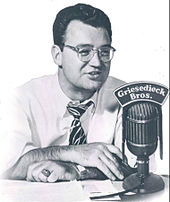
In St. Louis, Audacy-owned KMOX (1120 AM) airs Cardinals games over radio and feeds the rest of the Cardinals network. Capable of reaching 21 million listeners in nine states including Missouri, Illinois, Arkansas, Indiana, Iowa, Kentucky, Mississippi, Oklahoma, and Tennessee, the Cardinals radio network is the second-largest in MLB with 117 affiliate stations.[15]
Ricky Horton and John Rooney alternate as play-by-play announcers, with Matt Pauley serving as pre-game and post-game host. KMOX's 50,000-watt clear-channel signal covers much of the continental United States at night. At one time, owing to the Cardinals' status as a "regional" franchise, the Cardinals radio network reached almost half of the country.
The 2011 season marked the Cardinals' return to KMOX following five seasons on KTRS (550 AM), a station which is 50 percent owned by the Cardinals. With a partnership spanning seven decades, and continuously since 1954, its conclusion was realized after the 2005 season when the then owners of KMOX, CBS Radio, and the Cardinals failed to reach terms on a new rights agreement. However, frustrated by the underpowered coverage of 5,000-watt KTRS, the Cardinals reached a new deal with KMOX in 2011.
Starting in 2013 (at age 74), Mike Shannon started reducing his workload. As of the 2016 season, he only called home games for the Cardinals. As of the 2019 season, his 47th in the broadcast booth, he surpassed Jack Buck, his long-time broadcast companion, as the longest-tenured Cardinal broadcaster.
On January 14, 2021, Shannon announced that the upcoming season, his 50th season in the broadcast booth, would be his last.[214]
Television
[edit]Since 2000, Cardinals telecasts have generated the top three in ratings in MLB every season.[15] Bally Sports Midwest airs all games in high-definition and is the team's exclusive television broadcaster, with the exception of selected Saturday afternoon games on Fox (via its St. Louis affiliate, KTVI) or Sunday Night Baseball on ESPN. Bally Sports Indiana, Bally Sports South, Bally Sports Oklahoma, Bally Sports Southwest, and Bally Sports Southeast air Cardinals games for fans living within the Cardinals broadcast territory who do not receive the Bally Sports Midwest channel. During the 2016 season, the Cardinals averaged an 8.54 rating and 104,000 viewers on primetime TV broadcasts in St Louis.[215]
The television commentators lineup includes Chip Caray, Brad Thompson, and Jim Edmonds. Jimmy "The Cat" Hayes serves as dugout reporter during the game as well as on Cardinals Live, a pre- and post-game show. Cardinals Live is hosted in-studio by Alexa Datt along with game analysts and former Cardinals players Al Hrabosky and Rick Ankiel.[216][217]
Cardinals Kids, a program aimed at the team's younger fans, airs weekly in-season on Fox Sports Midwest. It is hosted by former Cardinals pitcher Brad Thompson, team mascot Fredbird, and Busch Stadium Public Address announcer John "The U-Man" Ulett. The 30-minute show began airing in 2003 and presents team news, player profiles, and Cardinals team history in a kid-friendly manner along with games and trivia.[218]
A weekly magazine program, This Week in Cardinal Nation, airs on St. Louis' NBC affiliate KSDK. Cardinals games had been seen on KSDK (and its predecessor, KSD-TV) from 1947 through 1958, 1963 through 1987, and 2007 until 2010. KPLR-TV was the Cardinals' other over-the-air broadcaster, carrying games from 1959 through 1962 and from 1988 until 2006.
Former Cardinals broadcasters include Jack Buck, Harry Caray, Bob Carpenter, Dizzy Dean, Joe Garagiola, Dan McLaughlin, and Jay Randolph. Joe Buck, the son of Jack Buck, was an official member of the Cardinals' broadcast team from 1991 until 2007. The younger Buck once served as the lead play-by-play caller for Fox Sports' national Major League Baseball and National Football League broadcasts before joining ESPN as the voice of Monday Night Football in 2022.
Opening Day lineups
[edit]| Year | 1 | 2 | 3 | 4 | 5 | 6 | 7 | 8 | 9 | P |
|---|---|---|---|---|---|---|---|---|---|---|
| 2024[219] | Brendan Donovan LF | Paul Goldschmidt 1B | Nolan Gorman 2B | Nolan Arenado 3B | Willson Contreras C | Alec Burleson DH | Jordan Walker RF | Victor Scott II CF | Masyn Winn SS | Miles Mikolas P |
| 2023[220] | Brendan Donovan 2B | Lars Nootbaar LF | Paul Goldschmidt 1B | Nolan Arenado 3B | Willson Contreras C | Tyler O'Neill CF | Nolan Gorman DH | Jordan Walker RF | Tommy Edman SS | Miles Mikolas P |
| 2022[221] | Dylan Carlson RF | Paul Goldschmidt 1B | Tyler O'Neill LF | Nolan Arenado 3B | Albert Pujols DH | Paul DeJong SS | Yadier Molina C | Harrison Bader CF | Tommy Edman 2B | Adam Wainwright P |
| 2021[222] | Tommy Edman 2B | Paul Goldschmidt 1B | Nolan Arenado 3B | Paul DeJong SS | Tyler O'Neill LF | Yadier Molina C | Dylan Carlson CF | Justin Williams RF | Jack Flaherty P | |
| 2020[223] | Kolten Wong 2B | Tommy Edman 3B | Paul Goldschmidt 1B | Paul DeJong SS | Matt Carpenter DH | Yadier Molina C | Dexter Fowler RF | Tyler O'Neill LF | Harrison Bader CF | Jack Flaherty P |
| 2019[224] | Matt Carpenter 3B | Paul Goldschmidt 1B | Paul DeJong SS | Marcell Ozuna LF | Yadier Molina C | Dexter Fowler RF | Kolten Wong 2B | Harrison Bader CF | Miles Mikolas P | |
| 2018[225] | Dexter Fowler RF | Tommy Pham CF | Matt Carpenter 3B | Marcell Ozuna LF | José Martínez 1B | Yadier Molina C | Paul DeJong SS | Kolten Wong 2B | Carlos Martínez P | |
| 2017[226] | Dexter Fowler CF | Aledmys Díaz SS | Matt Carpenter 1B | Jhonny Peralta 3B | Yadier Molina C | Stephen Piscotty RF | Jedd Gyorko 2B | Randal Grichuk LF | Carlos Martínez P | |
| 2016[227] | Matt Carpenter 3B | Tommy Pham LF | Matt Holliday 1B | Randal Grichuk CF | Stephen Piscotty RF | Yadier Molina C | Kolten Wong 2B | Jedd Gyorko SS | Adam Wainwright P | |
| 2015[228] | Matt Carpenter 3B | Jason Heyward RF | Matt Holliday LF | Jhonny Peralta SS | Matt Adams 1B | Yadier Molina C | Kolten Wong 2B | Jon Jay CF | Adam Wainwright P | |
| 2014[229] | Matt Carpenter 3B | Kolten Wong 2B | Matt Holliday LF | Allen Craig RF | Yadier Molina C | Matt Adams 1B | Jhonny Peralta SS | Peter Bourjos CF | Adam Wainwright P | |
| 2013[230] | Jon Jay CF | Matt Carpenter 2B | Matt Holliday LF | Allen Craig 1B | Carlos Beltrán RF | Yadier Molina C | Daniel Descalso 2B | Pete Kozma SS | Adam Wainwright P | |
| 2012[231] | Rafael Furcal SS | Carlos Beltrán RF | Matt Holliday LF | Lance Berkman 1B | David Freese 3B | Yadier Molina C | Jon Jay CF | Daniel Descalso 2B | Kyle Lohse P | |
| 2011[232] | Ryan Theriot SS | Colby Rasmus CF | Albert Pujols 1B | Matt Holliday LF | Lance Berkman RF | David Freese 3B | Yadier Molina C | Skip Schumaker 2B | Chris Carpenter P | |
| 2010[233] | Skip Schumaker 2B | Brendan Ryan SS | Albert Pujols 1B | Matt Holliday LF | Colby Rasmus CF | Ryan Ludwick RF | Yadier Molina C | David Freese 3B | Chris Carpenter P | |
| 2009[234] | Brendan Ryan 2B | Rick Ankiel CF | Albert Pujols 1B | Khalil Greene SS | Ryan Ludwick RF | Yadier Molina C | Chris Duncan LF | Brian Barden 3B | Adam Wainwright P | |
| 2008[235] | Skip Schumaker RF | Chris Duncan LF | Albert Pujols 1B | Rick Ankiel CF | Troy Glaus 3B | Yadier Molina C | Adam Kennedy 2B | Kyle Lohse P | César Izturis SS | |
| 2007[236] | David Eckstein SS | Preston Wilson RF | Albert Pujols 1B | Scott Rolen 3B | Yadier Molina C | Jim Edmonds CF | So Taguchi LF | Adam Kennedy 2B | Chris Carpenter P | |
| 2006[237] | David Eckstein SS | Juan Encarnación RF | Albert Pujols 1B | Jim Edmonds CF | Scott Rolen 3B | So Taguchi LF | Yadier Molina C | Aaron Miles 2B | Chris Carpenter P | |
| 2005[238] | David Eckstein SS | Larry Walker RF | Albert Pujols 1B | Scott Rolen 3B | Jim Edmonds CF | Mark Grudzielanek 2B | Reggie Sanders LF | Yadier Molina C | Chris Carpenter P | |
| 2004[239] | Tony Womack 2B | Ray Lankford LF | Albert Pujols 1B | Jim Edmonds CF | Scott Rolen 3B | Édgar Rentería SS | Reggie Sanders RF | Mike Matheny C | Matt Morris P | |
| 2003[240] | Fernando Viña 2B | Édgar Rentería SS | Jim Edmonds CF | Albert Pujols LF | Scott Rolen 3B | Tino Martinez 1B | Eli Marrero RF | Mike Matheny C | Matt Morris P | |
| 2002[241] | Fernando Viña 2B | Placido Polanco 3B | J. D. Drew RF | Albert Pujols LF | Jim Edmonds CF | Édgar Rentería SS | Tino Martinez 1B | Mike DiFelice C | Matt Morris P | |
| 2001[242] | Fernando Viña 2B | Édgar Rentería SS | Jim Edmonds CF | Mark McGwire 1B | Placido Polanco 3B | Albert Pujols LF | Mike Matheny C | J. D. Drew RF | Darryl Kile P | |
| 2000[243] | Fernando Viña 2B | Édgar Rentería SS | Ray Lankford LF | Fernando Tatís 3B | Jim Edmonds CF | Craig Paquette 1B | Eric Davis RF | Mike Matheny C | Darryl Kile P | |
| 1999[244] | Édgar Rentería SS | Jim Edmonds CF | Mark McGwire 1B | Eric Davis RF | Fernando Tatís 3B | Shawon Dunston LF | Eli Marrero C | Placido Polanco 2B | Donovan Osborne P | |
| 1998[245] | Royce Clayton SS | Delino DeShields 2B | Mark McGwire 1B | Ray Lankford CF | Brian Jordan RF | Ron Gant LF | Gary Gaetti 3B | Tom Lampkin C | Todd Stottlemyre P | |
| 1997[246] | Delino DeShields 2B | Royce Clayton SS | Willie McGee RF | Brian Jordan CF | Ron Gant LF | Gary Gaetti 3B | John Mabry 1B | Tom Lampkin C | Todd Stottlemyre P | |
| 1996[247] | Willie McGee RF | Royce Clayton SS | Ray Lankford CF | Ron Gant LF | Gary Gaetti 3B | John Mabry 1B | Pat Borders C | Luis Alicea 2B | Andy Benes P | |
| 1995[248] | Bernard Gilkey LF | Ozzie Smith SS | Ray Lankford CF | Scott Cooper 3B | Brian Jordan RF | John Mabry 1B | Tom Pagnozzi C | Manuel Lee 2B | Ken Hill P | |
| 1994[249] | Ray Lankford CF | Ozzie Smith SS | Gregg Jefferies 1B | Todd Zeile 3B | Mark Whiten RF | Bernard Gilkey LF | Luis Alicea 2B | Erik Pappas C | Bob Tewksbury P | |
| 1993[250] | Gerónimo Peña 2B | Ozzie Smith SS | Gregg Jefferies 1B | Ray Lankford CF | Mark Whiten RF | Todd Zeile 3B | Bernard Gilkey LF | Tom Pagnozzi C | Bob Tewksbury P | |
| 1992[251] | Ray Lankford CF | Ozzie Smith SS | Todd Zeile 3B | Andrés Galarraga 1B | Pedro Guerrero LF | Milt Thompson RF | Tom Pagnozzi C | José Oquendo 2B | José DeLeón P | |
| 1991[252] | Rex Hudler CF | Ozzie Smith SS | Bernard Gilkey LF | Pedro Guerrero 1B | Félix José RF | Todd Zeile 3B | Tom Pagnozzi C | José Oquendo 2B | Bryn Smith P | |
| 1990[253] | Vince Coleman LF | Willie McGee CF | Todd Zeile C | Pedro Guerrero 1B | Terry Pendleton 3B | Tom Brunansky RF | Ozzie Smith SS | José Oquendo 2B | Joe Magrane P | |
| 1989[254] | Vince Coleman LF | Willie McGee CF | Terry Pendleton 3B | Pedro Guerrero 1B | Tom Brunansky RF | José Oquendo SS | Tony Peña C | Tim Jones 2B | Joe Magrane P | |
| 1988[255] | Vince Coleman LF | Ozzie Smith SS | Tom Herr 2B | Bob Horner 1B | Willie McGee CF | Terry Pendleton 3B | Tony Peña C | Jim Lindeman RF | Joe Magrane P | |
| 1987[256] | Vince Coleman LF | Ozzie Smith SS | Tom Herr 2B | Jack Clark 1B | Jim Lindeman RF | Tony Peña C | Terry Pendleton 3B | Tito Landrum CF | John Tudor P | |
| 1986[257] | Vince Coleman LF | Willie McGee CF | Tom Herr 2B | Jack Clark 1B | Andy Van Slyke RF | Terry Pendleton 3B | Mike Heath C | Ozzie Smith SS | John Tudor P | |
| 1985[258] | Lonnie Smith LF | Tom Herr 2B | Terry Pendleton 3B | Jack Clark 1B | Darrell Porter C | Steve Braun RF | Andy Van Slyke CF | Ozzie Smith SS | Joaquín Andújar P | |
| 1984[259] | Lonnie Smith LF | Ken Oberkfell 3B | Tom Herr 2B | George Hendrick RF | Art Howe 1B | Willie McGee CF | Darrell Porter C | Ozzie Smith SS | Dave LaPoint P | |
| 1983[260] | Lonnie Smith LF | Ozzie Smith SS | Keith Hernandez 1B | George Hendrick RF | David Green CF | Darrell Porter C | Ken Oberkfell 3B | Mike Ramsey 2B | Bob Forsch P | |
| 1982[261] | Lonnie Smith CF | Tom Herr 2B | Keith Hernandez 1B | Darrell Porter C | George Hendrick RF | Dane Iorg LF | Steve Braun 3B | Ozzie Smith SS | Bob Forsch P | |
| 1981[262] | Garry Templeton SS | Ken Oberkfell 3B | Keith Hernandez 1B | George Hendrick RF | Darrell Porter C | Sixto Lezcano LF | Tony Scott CF | Tom Herr 2B | Bob Forsch P | |
| 1980[263] | Garry Templeton SS | Ken Oberkfell 2B | Keith Hernandez 1B | Ted Simmons C | Bobby Bonds LF | George Hendrick RF | Tony Scott CF | Ken Reitz 3B | Pete Vuckovich P | |
| 1979[264] | Lou Brock LF | Garry Templeton SS | Keith Hernandez 1B | Ted Simmons C | George Hendrick CF | Tony Scott RF | Ken Reitz 3B | Mike Tyson 2B | John Denny P | |
| 1978[265] | Lou Brock LF | Garry Templeton SS | Jerry Morales RF | Ted Simmons C | Keith Hernandez 1B | Ken Reitz 3B | Tony Scott CF | Mike Tyson 2B | Bob Forsch P | |
| 1977[266] | Lou Brock LF | Garry Templeton SS | Bake McBride CF | Héctor Cruz RF | Ted Simmons C | Keith Hernandez 1B | Ken Reitz 3B | Mike Tyson 2B | John Denny P | |
| 1976[267] | Lou Brock LF | Lee Richard SS | Bake McBride CF | Ted Simmons C | Reggie Smith RF | Keith Hernandez 1B | Héctor Cruz 3B | Mike Tyson 2B | Lynn McGlothen P | |
| 1975[268] | Lou Brock LF | Ted Sizemore 2B | Bake McBride CF | Reggie Smith RF | Ted Simmons C | Keith Hernandez 1B | Ken Reitz 3B | Ed Brinkman SS | Bob Gibson P | |
| 1974[269] | Lou Brock LF | Ted Sizemore 2B | Reggie Smith RF | Joe Torre 1B | Ted Simmons C | Bake McBride CF | Ken Reitz 3B | Mike Tyson SS | Bob Gibson P | |
| 1973[270] | Lou Brock LF | Ted Sizemore 2B | José Cruz CF | Joe Torre 1B | Ted Simmons C | Ken Reitz 3B | Bernie Carbo RF | Ray Busse SS | Bob Gibson P | |
| 1972[271] | Lou Brock LF | Ted Sizemore 2B | Matty Alou RF | Joe Torre 3B | Ted Simmons C | Joe Hague 1B | José Cruz CF | Dal Maxvill SS | Bob Gibson P | |
| 1971[272] | Matty Alou CF | Ted Sizemore SS | Lou Brock LF | Joe Torre 3B | José Cardenal RF | Joe Hague 1B | Ted Simmons C | Julián Javier 2B | Bob Gibson P | |
| 1970[273] | Lou Brock LF | José Cardenal CF | Dick Allen 3B | Joe Torre C | Leron Lee RF | Joe Hague 1B | Julián Javier 2B | Dal Maxvill SS | Bob Gibson P | |
| 1969[274] | Lou Brock LF | Curt Flood CF | Vada Pinson RF | Joe Torre 1B | Tim McCarver C | Mike Shannon 3B | Julián Javier 2B | Dal Maxvill SS | Bob Gibson P | |
| 1968[275] | Lou Brock LF | Curt Flood CF | Roger Maris RF | Orlando Cepeda 1B | Tim McCarver C | Mike Shannon 3B | Julián Javier 2B | Dal Maxvill SS | Bob Gibson P | |
| 1967[276] | Lou Brock LF | Curt Flood CF | Roger Maris RF | Orlando Cepeda 1B | Mike Shannon 3B | Tim McCarver C | Julián Javier 2B | Dal Maxvill SS | Bob Gibson P | |
| 1966[277] | Lou Brock RF | Julián Javier 2B | Curt Flood CF | Tim McCarver C | Charley Smith 3B | Alex Johnson LF | George Kernek 1B | Jerry Buchek SS | Curt Simmons P | |
| 1965[278] | Curt Flood CF | Lou Brock LF | Bill White 1B | Ken Boyer 3B | Dick Groat SS | Mike Shannon RF | Julián Javier 2B | Bob Uecker C | Bob Gibson P | |
| 1964[279] | Julián Javier 2B | Dick Groat SS | Bill White 1B | Charlie James LF | Ken Boyer 3B | Carl Warwick RF | Curt Flood CF | Bob Uecker C | Ernie Broglio P | |
| 1963[280] | Curt Flood CF | Dick Groat SS | Bill White 1B | George Altman RF | Ken Boyer 3B | Stan Musial LF | Carl Sawatski C | Julián Javier 2B | Ernie Broglio P | |
| 1962[281] | Curt Flood CF | Julián Javier 2B | Bill White 1B | Stan Musial RF | Ken Boyer 3B | Minnie Miñoso LF | Gene Oliver C | Julio Gotay SS | Larry Jackson P | |
| 1961[282] | Julián Javier 2B | Don Landrum CF | Bill White 1B | Ken Boyer 3B | Stan Musial LF | Daryl Spencer SS | Joe Cunningham RF | Hal Smith C | Ernie Broglio P | |
| 1960[283] | Joe Cunningham RF | Daryl Spencer SS | Bill White CF | Ken Boyer 3B | Stan Musial 1B | Leon Wagner LF | Hal Smith C | Alex Grammas 2B | Larry Jackson P | |
| 1959[284] | Don Blasingame 2B | Gino Cimoli CF | Bill White 1B | Ken Boyer 3B | Stan Musial LF | Joe Cunningham RF | Hal Smith C | Alex Grammas SS | Larry Jackson P | |
| 1958[285] | Don Blasingame 2B | Alvin Dark SS | Stan Musial 1B | Del Ennis LF | Ken Boyer 3B | Wally Moon RF | Bobby Smith CF | Hobie Landrith C | Vinegar Bend Mizell P | |
| 1957[286] | Don Blasingame 2B | Alvin Dark SS | Stan Musial 1B | Del Ennis RF | Ken Boyer 3B | Wally Moon LF | Hal Smith C | Bobby Smith CF | Herm Wehmeier P | |
| 1956[287] | Wally Moon 1B | Red Schoendienst 2B | Stan Musial RF | Hank Sauer LF | Ken Boyer 3B | Bill Virdon CF | Bill Sarni C | Alex Grammas SS | Vinegar Bend Mizell P | |
| 1955[288] | Wally Moon LF | Bill Virdon CF | Stan Musial 1B | Rip Repulski RF | Red Schoendienst 2B | Ken Boyer 3B | Bill Sarni C | Alex Grammas SS | Brooks Lawrence P | |
| 1954[289] | Rip Repulski RF | Wally Moon CF | Red Schoendienst 2B | Stan Musial LF | Ray Jablonski 3B | Tom Alston 1B | Alex Grammas SS | Del Rice C | Harvey Haddix P | |
| 1953[290] | Solly Hemus SS | Red Schoendienst 2B | Stan Musial LF | Steve Bilko 1B | Enos Slaughter RF | Ray Jablonski 3B | Rip Repulski CF | Del Rice C | Gerry Staley P | |
| 1952[291] | Solly Hemus SS | Red Schoendienst 2B | Stan Musial LF | Enos Slaughter RF | Wally Westlake CF | Steve Bilko 1B | Billy Johnson 3B | Del Rice C | Gerry Staley P | |
| 1951[292] | Peanuts Lowrey CF | Red Schoendienst 2B | Enos Slaughter RF | Stan Musial LF | Don Richmond 3B | Steve Bilko 1B | Joe Garagiola C | Solly Hemus SS | Tom Poholsky P | |
| 1950[293] | Harry Walker CF | Red Schoendienst 2B | Stan Musial RF | Enos Slaughter LF | Eddie Kazak 3B | Rocky Nelson 1B | Joe Garagiola C | Eddie Miller SS | Gerry Staley P | |
| 1949[294] | Tommy Glaviano 3B | Red Schoendienst 2B | Stan Musial CF | Enos Slaughter LF | Nippy Jones 1B | Ron Northey RF | Marty Marion SS | Del Rice C | Harry Brecheen P | |
| 1948[295] | Erv Dusak CF | Red Schoendienst 2B | Stan Musial RF | Enos Slaughter LF | Whitey Kurowski 3B | Nippy Jones 1B | Del Wilber C | Marty Marion SS | Murry Dickson P | |
| 1947[296] | Red Schoendienst 2B | Harry Walker CF | Stan Musial 1B | Enos Slaughter RF | Whitey Kurowski 3B | Dick Sisler LF | Marty Marion SS | Joe Garagiola C | Howie Pollet P | |
| 1946[297] | Lou Klein 2B | Terry Moore CF | Stan Musial LF | Enos Slaughter RF | Whitey Kurowski 3B | Dick Sisler 1B | Marty Marion SS | Del Rice C | Johnny Beazley P | |
| 1945[298] | Augie Bergamo RF | Johnny Hopp CF | Red Schoendienst LF | Walker Cooper C | Ray Sanders 1B | Whitey Kurowski 3B | Marty Marion SS | Emil Verban 2B | Ted Wilks P | |
| 1944[299] | Emil Verban 2B | Johnny Hopp CF | Stan Musial RF | Walker Cooper C | Ray Sanders 1B | Whitey Kurowski 3B | Danny Litwhiler LF | Marty Marion SS | Max Lanier P | |
| 1943[300] | Jimmy Brown 2B | Frank Demaree RF | Stan Musial LF | Whitey Kurowski 3B | Walker Cooper C | Buster Adams CF | Johnny Hopp 1B | Lou Klein SS | Mort Cooper P | |
| 1942[301] | Creepy Crespi 2B | Stan Musial LF | Terry Moore CF | Enos Slaughter RF | Ray Sanders 1B | Jimmy Brown 3B | Ken O'Dea C | Marty Marion SS | Mort Cooper P | |
| 1941[302] | Ernie Koy LF | Jimmy Brown 3B | Terry Moore CF | Johnny Mize 1B | Enos Slaughter RF | Gus Mancuso C | Marty Marion SS | Creepy Crespi 2B | Lon Warneke P | |
| 1940[303] | Jimmy Brown 3B | Stu Martin 2B | Enos Slaughter RF | Johnny Mize 1B | Don Padgett C | Pepper Martin LF | Terry Moore CF | Marty Marion SS | Curt Davis P | |
| 1939[304] | Jimmy Brown 2B | Don Gutteridge 3B | Enos Slaughter RF | Joe Medwick LF | Johnny Mize 1B | Terry Moore CF | Mickey Owen C | Joe Orengo SS | Bob Weiland P | |
| 1938[305] | Don Gutteridge SS | Stu Martin 2B | Enos Slaughter RF | Don Padgett LF | Johnny Mize 1B | Pepper Martin 3B | Terry Moore CF | Mickey Owen C | Bob Weiland P | |
| 1937[306] | Terry Moore CF | Stu Martin 2B | Frenchy Bordagaray 3B | Joe Medwick LF | Johnny Mize 1B | Pepper Martin RF | Leo Durocher SS | Bruce Ogrodowski C | Dizzy Dean P | |
| 1936[307] | Terry Moore CF | Frankie Frisch 2B | Pepper Martin RF | Joe Medwick LF | Ripper Collins 1B | Spud Davis C | Charlie Gelbert 3B | Leo Durocher SS | Dizzy Dean P | |
| 1935[308] | Pepper Martin 3B | Jack Rothrock RF | Frankie Frisch 2B | Joe Medwick LF | Ripper Collins 1B | Bill DeLancey C | Terry Moore CF | Leo Durocher SS | Dizzy Dean P | |
| 1934[309] | Terry Moore CF | Frankie Frisch 2B | Pepper Martin 3B | Jack Rothrock LF | Joe Medwick RF | Ripper Collins 1B | Spud Davis C | Leo Durocher SS | Dizzy Dean P | |
| 1933[310] | Sparky Adams 3B | George Watkins RF | Frankie Frisch 2B | Ripper Collins 1B | Joe Medwick LF | Ernie Orsatti CF | Jimmie Wilson C | Gordon Slade SS | Dizzy Dean P | |
| 1932[311] | Sparky Adams 3B | Ray Blades RF | Frankie Frisch 2B | Jim Bottomley 1B | Ripper Collins LF | Pepper Martin CF | Jimmie Wilson C | Charlie Gelbert SS | Flint Rhem P | |
| 1931[312] | Taylor Douthit CF | Ernie Orsatti LF | Frankie Frisch 2B | Jim Bottomley 1B | George Watkins RF | Charlie Gelbert SS | Sparky Adams 3B | Jimmie Wilson C | Flint Rhem P | |
| 1930[313] | Taylor Douthit CF | Sparky Adams 2B | Frankie Frisch 3B | Jim Bottomley 1B | Chick Hafey LF | Showboat Fisher RF | Charlie Gelbert SS | Jimmie Wilson C | Flint Rhem P | |
| 1929[314] | Taylor Douthit CF | Fred Haney 3B | Frankie Frisch 2B | Jim Bottomley 1B | Chick Hafey LF | Wally Roettger RF | Charlie Gelbert SS | Bubber Jonnard C | Grover Alexander P | |
| 1928[315] | Taylor Douthit CF | Wattie Holm 3B | Frankie Frisch 2B | Jim Bottomley 1B | Chick Hafey LF | Wally Roettger RF | Tommy Thevenow SS | Bob O'Farrell C | Jesse Haines P | |
| 1927[316] | Taylor Douthit CF | Billy Southworth RF | Frankie Frisch 2B | Jim Bottomley 1B | Les Bell 3B | Chick Hafey LF | Bob O'Farrell C | Tommy Thevenow SS | Grover Alexander P | |
| 1926[317] | Ray Blades LF | Heinie Mueller CF | Rogers Hornsby 2B | Jim Bottomley 1B | Chick Hafey RF | Les Bell 3B | Bob O'Farrell C | Tommy Thevenow SS | Flint Rhem P | |
| 1925[318] | Max Flack RF | Heinie Mueller CF | Rogers Hornsby 2B | Jim Bottomley 1B | Les Bell 3B | Wattie Holm LF | Walter Schmidt C | Tommy Thevenow SS | Jesse Haines P | |
| 1924[319] | Max Flack RF | Jack Smith LF | Rogers Hornsby 2B | Jim Bottomley 1B | Howard Freigau 3B | Heinie Mueller CF | Les Bell SS | Ernie Vick C | Johnny Stuart P | |
| 1923[320] | Ray Blades LF | Jack Smith RF | Rogers Hornsby 2B | Jim Bottomley 1B | Milt Stock 3B | Heinie Mueller CF | Howard Freigau SS | Eddie Ainsmith C | Jeff Pfeffer P | |
| 1922[321] | Les Mann CF | Del Gainer 1B | Milt Stock 3B | Rogers Hornsby 2B | Joe Schultz RF | Austin McHenry LF | Specs Toporcer SS | Verne Clemons C | Bill Sherdel P | |
| 1921[322] | Heinie Mueller RF | Cliff Heathcote CF | Milt Stock 3B | Rogers Hornsby LF | Jack Fournier 1B | Doc Lavan SS | Verne Clemons C | Specs Toporcer 2B | Jesse Haines P | |
| 1920[323] | Burt Shotton LF | Cliff Heathcote RF | Milt Stock 3B | Rogers Hornsby 2B | Jack Fournier 1B | Austin McHenry CF | Hal Janvrin SS | Verne Clemons C | Bill Doak P | |
| 1919[324] | Burt Shotton LF | Jack Smith RF | Austin McHenry CF | Rogers Hornsby SS | Milt Stock 3B | Gene Paulette 1B | Bob Fisher 2B | Frank Snyder C | Jakie May P | |
| 1918[325] | Red Smyth RF | Jack Smith CF | Doug Baird 3B | Rogers Hornsby SS | Walton Cruise LF | Gene Paulette 1B | Mike González C | Bruno Betzel 2B | Lee Meadows P | |
| 1917[326] | Bob Bescher LF | Bruno Betzel 2B | Tom Long RF | Dots Miller 1B | Rogers Hornsby SS | Walton Cruise CF | Fred Smith 3B | Frank Snyder C | Lee Meadows P | |
| 1916[327] | Bob Bescher LF | Zinn Beck 3B | Jack Smith CF | Dots Miller 1B | Tom Long RF | Bruno Betzel 2B | Rogers Hornsby SS | Frank Snyder C | Bill Doak P | |
| 1915[328] | Cozy Dolan CF | Miller Huggins 2B | Bob Bescher LF | Dots Miller 1B | Chief Wilson RF | Zinn Beck 3B | Rolla Daringer SS | Frank Snyder C | Slim Sallee P | |
| 1914[329] | Miller Huggins 2B | Lee Magee CF | Art Butler SS | Dots Miller 1B | Chief Wilson RF | Cozy Dolan 3B | Walton Cruise LF | Ivey Wingo C | Dan Griner P | |
| 1913[330] | Miller Huggins 2B | Lee Magee LF | Mike Mowrey 3B | Ed Konetchy 1B | Steve Evans RF | Rebel Oakes CF | Charley O'Leary SS | Ivey Wingo C | Dan Griner P | |
| 1912[331] | Miller Huggins 2B | Rube Ellis LF | Rebel Oakes CF | Ed Konetchy 1B | Steve Evans RF | Mike Mowrey 3B | Arnold Hauser SS | Jack Bliss C | Bob Harmon P | |
| 1911[332] | Miller Huggins 2B | Rube Ellis LF | Mike Mowrey 3B | Ed Konetchy 1B | Steve Evans RF | Roger Bresnahan C | Rebel Oakes CF | Arnold Hauser SS | Slim Sallee P | |
| 1910[333] | Miller Huggins 2B | Rube Ellis LF | Rebel Oakes CF | Ed Konetchy 1B | Steve Evans RF | Roger Bresnahan C | Rudy Hulswitt SS | Jap Barbeau 3B | Vic Willis P | |
| 1909[334] | Bobby Byrne 3B | Al Shaw CF | Roger Bresnahan C | Ed Konetchy 1B | Steve Evans RF | Joe Delahanty LF | Chappy Charles 2B | Champ Osteen SS | Johnny Lush P | |
| 1908[335] | Chappy Charles 3B | Shad Barry RF | Joe Delahanty LF | Ed Konetchy 1B | Red Murray CF | Bobby Byrne SS | Billy Gilbert 2B | Art Hoelskoetter C | Johnny Lush P | |
| 1907[336] | John Kelly RF | Tom O'Hara LF | Pug Bennett 2B | Jake Beckley 1B | Bobby Byrne 3B | Ed Holly SS | Al Burch CF | Doc Marshall C | Art Fromme P | |
| 1906[337] | Pug Bennett 2B | Spike Shannon LF | Mike Grady C | Homer Smoot RF | Jake Beckley 1B | Jack Himes CF | Harry Arndt 3B | George McBride SS | Jack Taylor P | |
| 1905[338] | John Farrell 2B | Spike Shannon LF | Homer Smoot CF | Dave Brain SS | Mike Grady 1B | Jack Dunleavy RF | Jimmy Burke 3B | Jack Warner C | Chappie McFarland P | |
| 1904[339] | John Farrell 2B | Spike Shannon RF | Homer Smoot CF | Jake Beckley 1B | Danny Shay SS | Jimmy Burke 3B | George Barclay LF | Bill Byers C | Jack Taylor P | |
| 1903[340] | John Farrell 2B | Homer Smoot CF | Dave Brain 3B | George Barclay LF | Patsy Donovan RF | Art Nichols 1B | Otto Williams SS | Jack Ryan C | Clarence Currie P | |
| 1902[341] | John Farrell 2B | George Barclay LF | Fred Hartman 3B | Homer Smoot CF | Otto Krueger SS | Patsy Donovan RF | Doc Hazelton 1B | Jack Ryan C | Stan Yerkes P | |
| 1901[342] | Jesse Burkett LF | Emmet Heidrick CF | Patsy Donovan RF | Dan McGann 1B | Bobby Wallace SS | Dick Padden 2B | Otto Krueger 3B | Jack Ryan C | Jack Powell P |
Opening Day salaries
[edit]Opening Day payrolls for 25-man roster (since 2000):[343] 2018–23 payroll obligations
2020 season shortened to 60 games. Payroll adjusted from $168,930,500 to $69,461,295.
| Opening Day Salary (ML contracts plus pro-rated signing bonuses) | ||||
| Year | Salary | |||
| 2000 | $63,900,000 | |||
| 2001 | $78,538,333 | |||
| 2002 | $74,660,875 | |||
| 2003 | $83,786,666 | |||
| 2004 | $83,228,333 | |||
| 2005 | $92,106,833 | |||
| 2006 | $88,891,371 | |||
| 2007 | $90,286,823 | |||
| 2008 | $99,624,449 | |||
| 2009 | $88,528,409 | |||
| 2010 | $94,220,500 | |||
| 2011 | $109,048,000 | |||
| 2012 | $111,858,500 | |||
| 2013 | $116,790,787 | |||
| 2014 | $111,250,000 (Google spreadsheet) | |||
| 2015 | $122,066,500 (Google spreadsheet) | |||
| 2016 | $145,553,500 (Google spreadsheet) | |||
| 2017 | $148,152,933 (Google spreadsheet) | |||
| 2018 | $159,698,667 (Google spreadsheet) | |||
| 2019 | $162,620,267 | |||
| 2020 | $168,930,500 [30-man OD payroll] Adj: $69,461,295 | |||
| 2021 | $163,542,500 [26-man OD payroll] | |||
| 2022 | $154,987,997 [28-man OD payroll] | |||
| 2023 | $176,587,308 [26-man OD payroll] | |||
| 2024 | $175,158,567 [26-man OD payroll] | |||
Notes
[edit]- ^ a.k.a. Busch Stadium (II) (1966–1982)
- ^ a.k.a. Cardinal Field (1917–1920), League Park (1899–1911), Sportsman's Park (II) (1893–1899)
- ^ a.k.a. Busch Stadium (I) (1953–1966)
- ^ In 1981, the Cardinals finished with the overall best record in the East Division. However, a players' strike in the middle of the season forced the season to be split into two halves. St. Louis finished second in both halves and was thereby deprived of a post-season appearance.
- ^ In 2001, the Cardinals and the Houston Astros finished the season with identical records of 93–69 and finished tied for first place in the Central Division standings. The Cardinals claimed it was a shared championship but MLB disagreed.[3] For playoff seeding, the NL Central slot went to Houston and St. Louis was awarded the wild card berth.
- ^ Most sources consider the 1882 Brown Stockings to represent the beginning of the St. Louis Cardinals (if it was not the even earlier 1875 or 1878 clubs) but the St. Louis Cardinals baseball club itself considers its history to have begun in 1892 when the team (still called the St. Louis Browns) joined the National League.[22][23]
- ^ Although the St. Louis Cardinals do not officially recognize their era in the American Association (AA) as part of their Major League history, Major League Baseball recognized that incarnation of the AA in 1968, as well as other historic leagues, existing as former Major Leagues.
References
[edit]- ^ Getzenberg, Alaina (September 18, 2017). "Schmidt's vision inspired iconic red bird logo". MLB.com. MLB Advanced Media. Retrieved December 2, 2018.
There are few logos in baseball as closely linked to a team as the "Birds on the Bat" is to the Cardinals. The red birds that are now inseparable from the Cardinal name, however, were not featured by the team in its earliest days. Rather, the name originally referred to the color cardinal red.
- ^ a b "Cardinals announce Stifel as club's first jersey patch sponsor". Cardinals.com (Press release). MLB Advanced Media. May 2, 2023. Retrieved May 28, 2023.
"We are proud to partner with Stifel in unveiling our first jersey patch sponsor," said St. Louis Cardinals President Bill DeWitt III. "We worked closely with Ron Kruszewski and his team at Stifel on the patch design to make sure it fit tastefully on our iconic uniform, and they even agreed to slightly modify their word mark to fit the red and blue color combination that we use for our classic 'Birds on the Bat' logo. Both Ron and I are confident that this design strikes the perfect balance between preserving the integrity of our uniform while providing great exposure for Stifel."
- ^ "St. Louis Cardinals History". ESPN. September 19, 2004. Archived from the original on September 26, 2019. Retrieved October 1, 2019.
- ^ "Cardinals Staff Directory". Cardinals.com. MLB Advanced Media. Retrieved November 20, 2023.
- ^ Hechtman, Jim (May 4, 2018). "How the Cardinals Strategy Leads to Success". The Hechtman Group. Retrieved November 13, 2022.
- ^ Noles, Chris (February 25, 2013). "3 Reasons the St. Louis Cardinals Have Had so Much Homegrown Success". Bleacher Report. Retrieved November 13, 2022.
- ^ a b c d e f g h i "St. Louis Cardinals Team History & Encyclopedia". Baseball-Reference.com. Retrieved February 13, 2013.
- ^ Eisenbath 1999: 251
- ^ a b c d e f g h "St. Louis Cardinals". Forbes. April 11, 2018. Retrieved April 12, 2018.
- ^ a b c d "St. Louis Cardinals". Forbes. March 23, 2016.
- ^ a b "St. Louis Cardinals". Forbes. March 2015.
- ^ a b c d e f g h i j k l m n o p q r s "Front Office Directory". Cardinals.com. MLB Advanced Media. Retrieved June 25, 2020.
- ^ Langosch, Jenifer (June 30, 2017). "Cards promote Mozeliak, name Girsch GM". Cardinals.com. MLB Advanced Media. Retrieved June 25, 2020.
- ^ Saunders, Patrick (August 2, 2012). "Cardinals fans get another vote as best in baseball". The Denver Post. Retrieved July 1, 2016.
- ^ a b c "Busch Stadium facts". St. Louis Cardinals. Archived from the original on December 19, 2015. Retrieved July 1, 2016.
- ^ "St. Louis Cardinals Team History & Encyclopedia". Baseball-Reference.com. Retrieved September 30, 2024.
- ^ Cash 2002: 38
- ^ a b "St. Louis Cardinals Team History & Encyclopedia". Baseball Reference. Retrieved October 24, 2014.
- ^ a b "St. Louis Cardinals (1882–2013)". Retrosheet. Retrieved October 24, 2014.
- ^ Suehsdorf, A. D. (1978). The Great American Baseball Scrapbook, p. 8. Random House. ISBN 0-394-50253-1
- ^ "1875 St. Louis Brown Stockings team page". Baseball-Reference.com. Retrieved January 10, 2013.
- ^ a b c d e f g h i j "Franchise Timeline". Cardinals.com. MLB Advanced Media. Retrieved June 14, 2021.
- ^ "Cardinals assert team history began in 1892". The Cardinal Nation Blog. August 21, 2009. Archived from the original on March 4, 2016. Retrieved October 24, 2014.
- ^ a b "Charlie Comiskey Managerial Record". Baseball-Reference.com. Retrieved March 26, 2013.
- ^ "Bob Caruthers player page". Baseball-Reference.com. Retrieved April 21, 2013.
- ^ "Tip O'Neill player page". Baseball-Reference.com. Retrieved April 21, 2013.
- ^ "Tip O'Neill awards". Baseball Almanac. Retrieved April 21, 2013.
- ^ a b c d "MLB Triple Crown Winners". Baseball-Reference.com. Retrieved April 21, 2013.
- ^ Cash, Jon David (2002). Before They Were Cardinals: Major League Baseball in Nineteenth-Century. St. Louis: University of Missouri Press.
- ^ a b "Busch Stadium Facts". Cardinals.com. MLB Advanced Media. Retrieved June 14, 2021.
- ^ Rogers, Anne (December 21, 2020). "How the Cardinals got their nickname". Cardinals.com. MLB Advanced Media. Retrieved June 14, 2021.
- ^ Uniform Database, which shows first Cardinal uniforms from 1900 to 1908, National Baseball Hall of Fame and Museum website.
- ^ "Baltimore Orioles on Baseball Almanac". Baseball-almanac.com. Retrieved June 3, 2013.
- ^ "Sam Breadon". baseballbiography.com. Retrieved June 3, 2013.
- ^ Doyle, Pat. "Branch Rickey's Farm – Minor League History". baseball-almanac.com. Retrieved June 3, 2013.
- ^ "On This Day: Branch Rickey, 83, dies in Missouri". The New York Times on the Web Learning Network. January 10, 1965. Retrieved January 24, 2013.
- ^ "Rogers Hornsby player page". Baseball-Reference.com. Retrieved April 21, 2013.
- ^ Doug Feldman. Dizzy and the Gashouse Gang: The 1934 St. Louis Cardinals and Depression-Era Baseball. Jefferson, NC: McFarland & Company, 2000. 215pp.
- ^ "Dizzy Dean player page". Baseball-Reference.com. Retrieved February 22, 2013.
- ^ "St. Louis Cardinals HOF Museum". MLB.com. Archived from the original on May 17, 2013. Retrieved February 23, 2013.
- ^ "Johnny Mize player page". Baseball-Reference.com. Retrieved April 21, 2013.
- ^ "Joe Medwick player page". Baseball-Reference.com. Retrieved April 21, 2013.
- ^ "Marty Marion player page". Baseball-Reference.com. Retrieved April 21, 2013.
- ^ "Enos Slaughter player page". Baseball-Reference.com. Retrieved April 21, 2013.
- ^ "Mort Cooper player page". Baseball-Reference.com. Retrieved April 21, 2013.
- ^ "Walker Cooper player page". Baseball-Reference.com. Retrieved April 21, 2013.
- ^ a b "Stan Musial player page". Baseball-Reference.com. Retrieved April 21, 2013.
- ^ "Max Lanier player page". Baseball-Reference.com. Retrieved April 21, 2013.
- ^ "Whitey Kurowski player page". Baseball-Reference.com. Retrieved April 21, 2013.
- ^ "Red Schoendienst player page". Baseball-Reference.com. Retrieved April 21, 2013.
- ^ "Johnny Beazley player page". Baseball-Reference.com. Retrieved April 21, 2013.
- ^ "Breakout selected from 1940 to 1949". Baseball-Reference.com. Retrieved October 6, 2013.
- ^ "Billy Southworth". Society for American Baseball Research. Retrieved February 23, 2013.
- ^ a b "Billy Southworth Managerial Record". Baseball-Reference.com. Retrieved March 26, 2013.
- ^ Fallstrom, A.B. (January 20, 2013). "Cardinals Hall of Famer Stan Musial Dies at 92". ABC News. Retrieved January 24, 2013.
- ^ Schwartz, Larry (October 17, 2005). "Slaughter's mad dash gives Cardinals the title". ESPN Classic. Archived from the original on December 3, 2013. Retrieved January 24, 2013.
- ^ "Bob Gibson player page". Baseball-Reference.com. Retrieved May 15, 2013.
- ^ "August Anheuser Busch Was Born". America's Library. July 30, 2011. Retrieved April 4, 2013.
- ^ "August Anheuser Busch Was Born". Sports Encyclopedia. April 23, 2008. Retrieved April 4, 2013.
- ^ "MLB Trade Deadline Can Be Great Deal of Trouble". The New York Times. July 30, 2011. Retrieved April 4, 2013.
- ^ Newhan, Ross (January 20, 2008). "1964 St. Louis Cardinals". Scout.com. Archived from the original on June 22, 2013. Retrieved April 5, 2013.
- ^ "Bill White player page". Baseball-Reference.com. Retrieved May 15, 2013.
- ^ "Steve Carlton player page". Baseball-Reference.com. Retrieved May 16, 2013.
- ^ "Curt Flood player page". Baseball-Reference.com. Retrieved May 15, 2013.
- ^ "Curt Simmons player page". Baseball-Reference.com. Retrieved May 15, 2013.
- ^ "Orlando Cepeda player page". Baseball-Reference.com. Retrieved May 15, 2013.
- ^ "1967 World Series". MLB.com. Retrieved May 15, 2013.
- ^ "1968 Major League Baseball Season Summary". Baseball-Reference.com. Retrieved April 5, 2013.
- ^ "World Series History: 1968 World Series". MLB.com. Retrieved April 5, 2013.
- ^ "1968: The Year of the Pitcher". Sports Illustrated. August 4, 1998. Archived from the original on May 21, 2013. Retrieved April 5, 2013.
- ^ "Joe Torre player page". Baseball-Reference.com. Retrieved April 24, 2013.
- ^ "Keith Hernandez player page". Baseball-Reference.com. Retrieved April 24, 2013.
- ^ Newhan, Ross (July 5, 1987). "A Deep Team Rises to Top Despite Injuries, Cardinals Are Flying High and Leading NL East". Los Angeles Times. p. Sports 3.
- ^ a b "Whitey Herzog Managerial Record". Baseball-Reference.com. Retrieved March 26, 2013.
- ^ Donovan, John (July 28, 2002). "Calling the Wizard". Sports Illustrated. Archived from the original on October 22, 2012. Retrieved May 14, 2013.
- ^ "Ozzie Smith player page". Baseball-Reference.com. Retrieved April 24, 2013.
- ^ "1982 World Series". Baseball-Reference.com. Retrieved May 14, 2013.
- ^ "Vintage Gallery: Memories of the last 'Suds Series". pjstar.com. October 11, 2011. Archived from the original on December 9, 2011. Retrieved May 15, 2013.
- ^ "1987 St. Louis Cardinals Batting, Pitching & Fielding statistics". Baseball-Reference.com. Retrieved May 14, 2013.
- ^ "1985 World Series". Baseball-Reference.com. Retrieved May 14, 2013.
- ^ a b "Chris Carpenter player page". Baseball-Reference.com. March 31, 2013.
- ^ Cart, Julie (September 30, 1989). "Patriarch of Cardinals Is Dead at 90: August A. Busch Jr., Beer Baron, Bought Baseball Team in '53". LA Times. Retrieved March 31, 2013.
- ^ "Anheuser-Busch Looking to Sell Cardinals". The Daily Reporter. October 26, 1995. Retrieved March 31, 2013.
- ^ a b "Joe Torre Managerial Record". Baseball-Reference.com. Retrieved March 26, 2013.
- ^ "AB Sell Cardinals". The New York Times. December 23, 1995. Retrieved February 24, 2013.
- ^ "Tony La Russa retires as manager, three days after winning World Series". NJ.com (Associated Press). October 31, 2011. Retrieved February 24, 2013.
- ^ "Mark McGwire's Seventy Home Run Season by Baseball Almanac". Archived from the original on August 17, 2007. Retrieved August 8, 2007.
- ^ "Breakout selected from 2000 to 2013". Sports Reference LLC. Retrieved October 6, 2013.
- ^ Goold, Derrick (December 24, 2011). "Cardinals recast the 'MV3'". stltoday.com. Retrieved June 3, 2012.
- ^ "Albert Pujols player page". Baseball-Reference.com. March 31, 2013.
- ^ "2004 St. Louis Cardinals team page". Baseball-Reference.com. March 31, 2013.
- ^ Morris, Patrick (February 6, 2008). "Cardinals win like never before". Los Angeles Times. Retrieved March 31, 2013.
- ^ "Top 10 Unlikely World Series Winners". RealClearSports. October 25, 2012. Archived from the original on September 24, 2015. Retrieved March 31, 2013.
- ^ "2006 St. Louis Cardinals team page". Baseball-Reference.com. March 31, 2013.
- ^ "American Association Remembered". MLB.com. May 7, 2007. Retrieved March 28, 2013.
- ^ "The St. Louis Cardinals' Greatest Moments". Back to Baseball. July 24, 2012. Archived from the original on March 10, 2016. Retrieved March 28, 2013.
- ^ Miklasz, Bernie (October 29, 2011). "Cardinals win like never before". St Louis Post-Dispatch. Retrieved October 29, 2011.
- ^ Strauss, Joe (October 22, 2011). "Pujols puts on historic display of power". St. Louis Post-Dispatch. Retrieved August 5, 2011.
- ^ DiComo, Anthony (October 28, 2011). "'Unbelievable' Game 6 ranks among the best". MLB.com. Retrieved November 1, 2012.
- ^ Jenkins, Bruce (October 12, 2012). "Cardinals carry on winning tradition". San Francisco Chronicle. Retrieved November 5, 2012.
- ^ "Cardinals to retire Tony La Russa's No. 10 jersey". USA Today. May 1, 2012. Archived from the original on July 2, 2017. Retrieved May 3, 2012 – via The Associated Press.
- ^ Cardinals Press Release (November 20, 2013). "Cardinals announce extension for Matheny". cleveland.indians.mlb.com. Archived from the original on March 7, 2014. Retrieved March 6, 2014.
- ^ Goold, Derrick (October 27, 2014). "Cards in disbelief over Taveras' death".
- ^ "Braves ship Heyward to Cards in 4-player deal". November 17, 2014.
- ^ Schmidt, Michael (June 16, 2015). "Cardinals Face F.B.I. Inquiry in Hacking of Astros' Database". The New York Times. Retrieved June 16, 2015.
- ^ "Cardinals bringing back blue jerseys". KSDK. Retrieved November 19, 2018.
- ^ "Arizona Diamondbacks trade Paul Goldschmidt to St. Louis Cardinals". ESPN. December 5, 2018. Retrieved December 8, 2018.
- ^ "Time-tested Waino-Yadi battery sets record that may never be broken". MLB.com. Retrieved September 19, 2022.
- ^ admin. "Most Starts By Two Batterymates – Society for American Baseball Research". Retrieved September 19, 2022.
- ^ "Busch Stadium Information – Directions". cardinals.com. Archived from the original on August 22, 2010. Retrieved May 27, 2013.
- ^ "Busch Stadium". ballparks.com. Retrieved May 27, 2013.
- ^ "Cardinals make 65,000 additional tickets available"[dead link] St. Louis Cardinals Press Release, April 28, 2006
- ^ Spector, Jesse (November 5, 2009). "27 things about those 27 New York Yankees World Series titles". New York Daily News.
- ^ "Park Factors for Busch Stadium, St. Louis". ParkFactors.com. ScoutingBook.com. Retrieved May 27, 2013.
- ^ Hoffert, Jess (June 25, 2012). "Busch Stadium". Midwest Living. Archived from the original on November 22, 2012. Retrieved May 27, 2013.
- ^ Kim, Roland (September 5, 2012). "Watching a Cardinals Game at Busch Stadium". Yahoo! Voices. Archived from the original on July 28, 2014.
- ^ Granillo, Larry (February 3, 2010). "Baseball's Best Statues, by Ballpark". wezen-ball.com.
- ^ Snyder, Matt (May 24, 2013). "PHOTO: Busch Stadium as a soccer venue". CBS Sports. Retrieved May 27, 2013.
- ^ Volkmann, Kelsey (July 18, 2011). "U2 rocks Busch Stadium in St. Louis". St. Louis Business Journal. Retrieved May 27, 2013.
- ^ Barker, Jacob (January 10, 2019). "As $261 million Ballpark Village project approaches opening, apartments already leasing". St. Louis Post-Dispatch. Retrieved January 10, 2019.
- ^ "Busch Stadium Ballpark Village Information". cardinals.com. Archived from the original on January 20, 2011. Retrieved April 6, 2014.
- ^ a b "Cardinals Ballparks". Cardinals.com. MLB Advanced Media. Retrieved June 14, 2021.
- ^ "St. Louis Cardinals Team History & Encyclopedia". Baseball-reference.com. Retrieved September 19, 2023.
- ^ "St. Louis Cardinals Attendance, Stadiums, and Park Factors". Baseball-Reference.com. Retrieved October 2, 2023.
- ^ "National Baseball Hall of Fame – Dressed to the Nines – Uniform Database".
- ^ a b Mark Stangl. "St. Louis Cardinals team ownership history". Society for American Baseball Research.
- ^ Getzenburg, Alaina (September 18, 2017). "Schmidt's vision inspired iconic red bird logo". MLB Advanced Media. Retrieved April 19, 2018.
- ^ a b c "Cardinals uniforms". Baseball Hall of Fame Uniform Database. Retrieved May 3, 2008.
- ^ Langosch, Jenifer (November 16, 2012). "City is key to Cardinals' alternate home jersey". MLB Advanced Media. Archived from the original on November 19, 2012. Retrieved April 19, 2018.
- ^ Clair, Michael (November 19, 2018). "The Cardinals brought back the powder blue jerseys with – get this – buttons!". MLB Advanced Media. Retrieved November 20, 2018.
- ^ "Cardinals Change Their Classic STL Cap Logo". August 8, 2019.
- ^ Denton, John (May 20, 2024). "'From The Lou and proud': Cards City Connects a fresh take on iconic brand". MLB Advanced Media. Retrieved May 20, 2024.
- ^ Britt, Crystal (October 7, 2011). "Fans hope Buschie the Rally Squirrel is good luck – KFVS12 News & Weather Cape Girardeau, Carbondale, Poplar Bluff". Kfvs12.com. Retrieved December 13, 2012.
- ^ Holleman, Joe (May 22, 2015). "Deadspin targets Fredbird over 'police lives matter' sign". St. Louis Post-Dispatch. St. Louis, MO. Retrieved October 1, 2021.
- ^ Lee, Tony (January 12, 2011). "Cubs, Cardinals Must Emulate Yankees, Red Sox to Rekindle Rivalry". NESN. Retrieved February 6, 2011.
- ^ "Dodgers-Cardinals rivalry going strong". June 28, 2014.
- ^ "The one-sided head-to-head playoff history of the Dodgers and St. Louis Cardinals". Los Angeles Times. October 4, 2021.
- ^ Ladson, Bill (June 16, 2023). "How the trade that made Keith Hernandez a Met came to be". MLB Advanced Media. Retrieved July 20, 2023.
- ^ Farrell, Nora (June 1, 2012). "Cardinals and Mets have long and colorful rivalry". KSDK. Retrieved July 20, 2023.
- ^ Muratore, Elizabeth (June 16, 2020). "Mets and Cardinals rivalry goes back much further than 2006". FanSided (Rising Apple). Retrieved July 20, 2023.
- ^ Crisafulli, Alex (August 25, 2016). "The Cardinals – Mets rivalry was the best rivalry". SB Nation (Viva El Birdos). Retrieved July 20, 2023.
- ^ Wright, Brian (May 17, 2022). "Memorable Games in Mets-Cardinals History". Metsmerized Online. Retrieved July 20, 2023.
- ^ "In defense of DeWit & Company". Scout.com. December 24, 2008. Archived from the original on June 22, 2013. Retrieved April 27, 2013.
- ^ a b "Baseball's Sign of the Times: Under New Ownership". Chicago Tribune. December 26, 1995. Retrieved April 27, 2013.
- ^ a b "Anheuser-Busch Puts Cardinals Up for Sale". Eugene Register-Guard. October 26, 1995. Retrieved April 27, 2013.
- ^ Judd 2002: 91
- ^ "Cards owners worth $4 billion". St. Louis Business Journal. May 6, 2001. Retrieved April 27, 2013.
- ^ "Cardinals group to buy up departing owners' stakes". St. Louis Business Journal. November 20, 2005. Retrieved April 26, 2013.
- ^ "DeWitt III defends Cardinals; releases owner names". St. Louis Business Journal. December 7, 2010. Retrieved April 27, 2013.
- ^ a b c "St. Louis Cardinals". Forbes. March 2024. Retrieved March 28, 2024.
- ^ Mike Ozanian (April 11, 2017). "Baseball Team Values 2017". Forbes.
- ^ Mike Ozanian (March 23, 2016). "Baseball's Most Valuable Teams". Forbes.
- ^ a b "St. Louis Cardinals – in photos: MLB valuations". Forbes. March 26, 2014. Retrieved March 30, 2014.
- ^ a b c "#10 St. Louis Cardinals". Forbes. March 26, 2013. Retrieved March 30, 2014.
- ^ "St. Louis Cardinals, LLC". Privco. March 26, 2013. Retrieved March 27, 2013.
- ^ "Baseball Team Values 2018". Forbes. April 11, 2018.
- ^ "#8 St. Louis Cardinals". Forbes. April 7, 2010. Archived from the original on April 11, 2010. Retrieved November 14, 2011.
- ^ "#11 St. Louis Cardinals". Forbes. March 23, 2011. Archived from the original on March 26, 2011. Retrieved November 14, 2011.
- ^ "#11 St. Louis Cardinals". Forbes. March 21, 2012. Retrieved March 22, 2012.
- ^ a b "St. Louis Cardinals on the Forbes MLB team valuations list". Forbes. Retrieved March 30, 2014.
- ^ "St. Louis Cardinals on the Forbes MLB team valuations list". Forbes. Retrieved July 10, 2015.
- ^ a b "St. Louis Cardinals". Forbes. April 11, 2017.
- ^ a b c Hummel, Rick (November 16, 2013). "Cardinals buy Memphis franchise". St. Louis Post-Dispatch. Retrieved November 16, 2013.
- ^ "Chris Von der Ahe Managerial Record". Baseball-Reference.com. Retrieved March 26, 2013.
- ^ "Patsy Donovan Managerial Record". Baseball-Reference.com. Retrieved March 26, 2013.
- ^ "Kid Nichols Managerial Record". Baseball-Reference.com. Retrieved July 18, 2018.
- ^ "John McCloskey Managerial Record". Baseball-Reference.com. Retrieved March 26, 2013.
- ^ "Roger Bresnahan Managerial Record". Baseball-Reference.com. Retrieved March 26, 2013.
- ^ "Miller Huggins Managerial Record". Baseball-Reference.com. Retrieved March 26, 2013.
- ^ "Jack Hendricks Managerial Record". Baseball-Reference.com. Retrieved July 18, 2018.
- ^ "Branch Rickey Managerial Record". Baseball-Reference.com. Retrieved March 26, 2013.
- ^ "Rogers Hornsby Managerial Record". Baseball-Reference.com. Retrieved October 3, 2017.
- ^ "Bob O'Farrell Managerial Record". Baseball-Reference.com. Retrieved July 18, 2018.
- ^ "Bill McKechnie Managerial Record". Baseball-Reference.com. Retrieved October 3, 2017.
- ^ "Gabby Street Managerial Record". Baseball-Reference.com. Retrieved March 26, 2013.
- ^ "Frankie Frisch Managerial Record". Baseball-Reference.com. Retrieved March 26, 2013.
- ^ "Ray Blades Managerial Record". Baseball-Reference.com. Retrieved October 3, 2017.
- ^ "Eddie Dyer Managerial Record". Baseball-Reference.com. Retrieved March 26, 2013.
- ^ "Marty Marion Managerial Record". Baseball-Reference.com. Retrieved July 18, 2018.
- ^ "Eddie Stanky Managerial Record". Baseball-Reference.com. Retrieved March 26, 2013.
- ^ "Fred Hutchinson Managerial Record". Baseball-Reference.com. Retrieved October 6, 2014.
- ^ "Solly Hemus Managerial Record". Baseball-Reference.com. Retrieved October 6, 2014.
- ^ "Johhny Keane Managerial Record". Baseball-Reference.com. Retrieved March 26, 2013.
- ^ "Red Schoendienst Managerial Record". Baseball-Reference.com. Retrieved March 26, 2013.
- ^ "Vern Rapp Managerial Record". Baseball-Reference.com. Retrieved July 18, 2018.
- ^ "Ken Boyer Managerial Record". Baseball-Reference.com. Retrieved October 6, 2014.
- ^ "Tony LaRussa Managerial Record". Baseball-Reference.com. Retrieved March 26, 2013.
- ^ "Mike Matheny Managerial Record". Baseball-Reference.com. Retrieved October 2, 2017.
- ^ "Mike Shildt Managerial Record". Baseball-Reference.com. Retrieved July 18, 2018.
- ^ "Oliver Marmol Managerial Record". Baseball-Reference.com. Retrieved October 30, 2021.
- ^ "Darryl Kile Award". Baseball-almanac.com. Retrieved December 13, 2012.
- ^ a b St. Louis Cardinals award winners and league leaders
- ^ NL MVP Awards by team
- ^ "St. Louis Cardinals". Baseball-almanac.com. Retrieved October 29, 2011.
- ^ "Triple Crown Winners". Baseball-Reference.com. Retrieved October 29, 2011.
- ^ "RBI records". Baseball-almanac.com. Retrieved October 29, 2011.
- ^ "Box score for Bottomley". Retrosheet.org. September 16, 1924. Retrieved October 29, 2011.
- ^ "Home run records". Baseball-almanac.com. Retrieved October 29, 2011.
- ^ "Box score". Retrosheet.org. September 7, 1993. Retrieved October 29, 2011.
- ^ "Cards hit 4 straight HRs! 11th time in history". MLB.com. Retrieved July 2, 2022.
- ^ "Baseball Almanac". Baseball Almanac. Retrieved October 29, 2011.
- ^ Hernandez, Keith (2018). I'm Keith Hernandez: A Memoir. New York: Little, Brown and Company. p. 223.
- ^ "Cardinals establish Hall of Fame & detail induction process" (Press release). St. Louis Cardinals. January 18, 2014. Archived from the original on January 26, 2014. Retrieved January 29, 2014.
- ^ "2021 Cardinals Hall of Fame ballot nominees announced". MLB.com. Retrieved November 26, 2021.
- ^ "Cardinals 2023 Hall of Fame induction class update". MLB.com. Retrieved June 17, 2023.
- ^ "Cardinals retired numbers". stlouis.cardinals.mlb.com. Archived from the original on June 12, 2018. Retrieved July 20, 2013.
- ^ Kiley, Gabriel (July 12, 2012). "A look at the Cardinals retired numbers". stlouis.cardinals.mlb.com. Archived from the original on January 9, 2015. Retrieved July 20, 2013.
- ^ Araton, Harvey (April 14, 2010). "Yankees' Mariano Rivera is the last No. 42". The New York Times.
- ^
Lupica, Matt (January 2012). "Busch Stadium". The Baseball Stadium Insider: A Comprehensive Dissection of All Thirty Ballparks, the Legendary Players, and the Memorable Moments. Bloomington, Indiana: iUniverse. p. 221.
A lifetime .358 hitter, Hornsby was inducted in the Hall of Fame in 1942, and the Cardinals honored him alongside the retired numbers with the 'SL' symbol due to his playing days predating the use of numbers.
- ^ Snyder, John. Cardinals Journal: Year by Year and Day by Day with the St. Louis Cardinals Since 1882. Clerisy Press. p. 689. ISBN 9781578604807.
- ^ a b c d e f "St. Louis Cardinals Top 10 Career Batting Leaders". Baseball-Reference.com. Retrieved July 19, 2020.
- ^ a b c d e f "St. Louis Cardinals Top 10 Career Pitching Leaders". Baseball-Reference.com. Retrieved July 19, 2020.
- ^ "St. Louis Cardinals Minor League Affiliates". Baseball-Reference. Sports Reference. Retrieved October 30, 2023.
- ^ "Cardinals plan season-long celebration for retiring broadcaster Shannon". St. Louis Post-Dispatch. March 18, 2021. Retrieved March 27, 2021.
- ^ Here Are The 2016 MLB Prime Time Television Ratings For Each Team – Maury Brown, Forbes SportsMoney, September 28, 2016
- ^ "Edmonds joins Fox Sports Midwest". Fox Sports Midwest.com. March 14, 2013. Archived from the original on June 16, 2013. Retrieved April 22, 2013.
- ^ "Chip Caray named Cardinals' new lead TV voice". MLB.com. January 30, 2023. Retrieved January 31, 2023.
- ^ "About Cardinals Kids". Cardinals Kids.com. 2013. Archived from the original on December 3, 2013. Retrieved April 22, 2013.
- ^ "St. Louis Cardinals at Los Angeles Dodgers Box Score, March 28, 2024". Baseball-Reference.com. March 28, 2024.
- ^ "Toronto Blue Jays at St. Louis Cardinals Box Score, March 30, 2023". Baseball-Reference.com. March 30, 2023.
- ^ "Pittsburgh Pirates at St. Louis Cardinals Box Score, April 7, 2022". Baseball-Reference.com. April 7, 2022.
- ^ "St. Louis Cardinals at Cincinnati Reds Box Score, April 1, 2021". Baseball-Reference.com. April 1, 2021.
- ^ "Pittsburgh Pirates at St. Louis Cardinals Box Score, July 24, 2020". Baseball-Reference.com. July 24, 2020.
- ^ "St. Louis Cardinals at Milwaukee Brewers Box Score, March 28, 2019". Baseball-Reference.com. March 28, 2019.
- ^ "St. Louis Cardinals at New York Mets Box Score, March 29, 2018". Baseball-Reference.com. March 29, 2018.
- ^ "Box Score of Game played on Sunday, April 2, 2017 at Busch Stadium III". Baseball-almanac.com. April 2, 2017. Retrieved December 27, 2017.
- ^ "Box Score of Game played on Sunday, April 3, 2016 at PNC Park". Baseball-almanac.com. April 3, 2016. Retrieved December 27, 2017.
- ^ "Box Score of Game played on Sunday, April 5, 2015 at Wrigley Field". Baseball-almanac.com. April 5, 2015. Retrieved December 27, 2017.
- ^ "Box Score of Game played on Monday, March 31, 2014 at Great American Ball Park". Baseball-almanac.com. March 31, 2014. Retrieved December 27, 2017.
- ^ "Box Score of Game played on Monday, April 1, 2013 at Chase Field". Baseball-almanac.com. April 1, 2013. Retrieved December 27, 2017.
- ^ "Box Score of Game played on Wednesday, April 4, 2012 at Marlins Park". Baseball-almanac.com. April 4, 2012. Retrieved December 27, 2017.
- ^ "Box Score of Game played on Thursday, March 31, 2011 at Busch Stadium III". Baseball-almanac.com. March 31, 2011. Retrieved December 27, 2017.
- ^ "Box Score of Game played on Monday, April 5, 2010 at Great American Ball Park". Baseball-almanac.com. April 5, 2010. Retrieved December 27, 2017.
- ^ "Box Score of Game played on Monday, April 6, 2009 at Busch Stadium III". Baseball-almanac.com. April 6, 2009. Retrieved December 27, 2017.
- ^ "Box Score of Game played on Tuesday, April 1, 2008 at Busch Stadium III". Baseball-almanac.com. April 1, 2008. Retrieved December 27, 2017.
- ^ "Box Score of Game played on Sunday, April 1, 2007 at Busch Stadium III". Baseball-almanac.com. April 1, 2007. Retrieved December 27, 2017.
- ^ "Box Score of Game played on Monday, April 3, 2006 at Citizens Bank Park". Baseball-almanac.com. April 3, 2006. Retrieved December 27, 2017.
- ^ "Box Score of Game played on Tuesday, April 5, 2005 at Minute Maid Park". Baseball-almanac.com. April 5, 2005. Retrieved December 27, 2017.
- ^ "Box Score of Game played on Monday, April 5, 2004 at Busch Stadium II". Baseball-almanac.com. April 5, 2003. Retrieved December 27, 2017.
- ^ "Box Score of Game played on Monday, March 31, 2003 at Busch Stadium II". Baseball-almanac.com. March 31, 2003. Retrieved December 27, 2017.
- ^ "Box Score of Game played on Monday, April 1, 2002 at Busch Stadium II". Baseball-almanac.com. April 1, 2002. Retrieved December 27, 2017.
- ^ "Box Score of Game played on Monday, April 2, 2001 at Coors Field". Baseball-almanac.com. April 2, 2001. Retrieved December 27, 2017.
- ^ "Box Score of Game played on Monday, April 3, 2000 at Busch Stadium II". Baseball-almanac.com. April 3, 2000. Retrieved December 27, 2017.
- ^ "Box Score of Game played on Monday, April 5, 1999 at Busch Stadium II". Baseball-almanac.com. April 5, 1999. Retrieved December 27, 2017.
- ^ "Box Score of Game played on Tuesday, March 31, 1998 at Busch Stadium II". Baseball-almanac.com. March 31, 1998. Retrieved December 27, 2017.
- ^ "Box Score of Game played on Tuesday, April 1, 1997 at Stade Olympique". Baseball-almanac.com. April 1, 1997. Retrieved December 27, 2017.
- ^ "Box Score of Game played on Monday, April 1, 1996 at Shea Stadium". Baseball-almanac.com. April 1, 1996. Retrieved December 27, 2017.
- ^ "Box Score of Game played on Wednesday, April 26, 1995 at Busch Stadium II". Baseball-almanac.com. April 26, 1995. Retrieved December 27, 2017.
- ^ "Box Score of Game played on Sunday, April 3, 1994 at Riverfront Stadium". Baseball-almanac.com. April 3, 1994. Retrieved December 27, 2017.
- ^ "Box Score of Game played on Sunday, April 6, 1993 at Busch Stadium II". Baseball-almanac.com. April 6, 1993. Retrieved December 27, 2017.
- ^ "Box Score of Game played on Monday, April 6, 1992 at Busch Stadium II". Baseball-almanac.com. April 6, 1992. Retrieved December 27, 2017.
- ^ "Box Score of Game played on Tuesday, April 9, 1991 at Wrigley Field". Baseball-almanac.com. April 9, 1991. Retrieved December 27, 2017.
- ^ "Box Score of Game played on Monday, April 9, 1990 at Busch Stadium II". Baseball-almanac.com. April 9, 1990. Retrieved December 27, 2017.
- ^ "Box Score of Game played on Monday, April 3, 1989 at Shea Stadium". Baseball-almanac.com. April 3, 1989. Retrieved December 27, 2017.
- ^ "Box Score of Game played on Monday, April 4, 1988 at Riverfront Stadium". Baseball-almanac.com. April 4, 1988. Retrieved December 27, 2017.
- ^ "Box Score of Game played on Tuesday, April 7, 1987 at Wrigley Field". Baseball-almanac.com. April 7, 1987. Retrieved December 27, 2017.
- ^ "Box Score of Game played on Tuesday, April 8, 1986 at Busch Stadium II". Baseball-almanac.com. April 8, 1986. Retrieved December 27, 2017.
- ^ "Box Score of Game played on Tuesday, April 9, 1985 at Shea Stadium". Baseball-almanac.com. April 9, 1985. Retrieved December 27, 2017.
- ^ "Box Score of Game played on Tuesday, April 3, 1984 at Dodger Stadium". Baseball-almanac.com. April 3, 1984. Retrieved December 27, 2017.
- ^ "Box Score of Game played on Tuesday, April 5, 1983 at Busch Stadium II". Baseball-almanac.com. April 5, 1983. Retrieved December 27, 2017.
- ^ "Box Score of Game played on Tuesday, April 6, 1982 at Astrodome". Baseball-almanac.com. April 6, 1982. Retrieved December 27, 2017.
- ^ "Box Score of Game played on Saturday, April 11, 1981 at Busch Stadium II". Baseball-almanac.com. April 11, 1981. Retrieved December 27, 2017.
- ^ "Box Score of Game played on Thursday, April 10, 1980 at Busch Stadium II". Baseball-almanac.com. April 10, 1980. Retrieved December 27, 2017.
- ^ "Box Score of Game played on Friday, April 6, 1979 at Busch Stadium II". Baseball-almanac.com. April 6, 1979. Retrieved December 27, 2017.
- ^ "Box Score of Game played on Friday, April 7, 1978 at Veteran's Stadium". Baseball-almanac.com. April 7, 1978. Retrieved December 27, 2017.
- ^ "Box Score of Game played on Thursday, April 7, 1977 at Three Rivers Stadium". Baseball-almanac.com. April 7, 1977. Retrieved December 27, 2017.
- ^ "Box Score of Game played on Friday, April 9, 1976 at Busch Stadium II". Baseball-almanac.com. April 9, 1976. Retrieved December 27, 2017.
- ^ "Box Score of Game played on Monday, April 7, 1975 at Busch Stadium II". Baseball-almanac.com. April 7, 1975. Retrieved December 27, 2017.
- ^ "Box Score of Game played on Friday, April 5, 1974 at Busch Stadium II". Baseball-almanac.com. April 5, 1974. Retrieved December 27, 2017.
- ^ "Box Score of Game played on Friday, April 6, 1973 at Three Rivers Stadium". Baseball-almanac.com. April 6, 1973. Retrieved December 27, 2017.
- ^ "Box Score of Game played on Saturday, April 15, 1972 at Busch Stadium II". Baseball-almanac.com. April 15, 1972. Retrieved December 27, 2017.
- ^ "Box Score of Game played on Tuesday, April 6, 1971 at Wrigley Field". Baseball-almanac.com. April 6, 1971. Retrieved December 27, 2017.
- ^ "Box Score of Game played on Wednesday, April 8, 1970 at Parc Jarry". Baseball-almanac.com. April 8, 1970. Retrieved December 27, 2017.
- ^ "Box Score of Game played on Tuesday, April 8, 1969 at Busch Stadium II". Baseball-almanac.com. April 8, 1969. Retrieved December 27, 2017.
- ^ "Box Score of Game played on Wednesday, April 10, 1968 at Busch Stadium II". Baseball-almanac.com. April 10, 1968. Retrieved December 27, 2017.
- ^ "Box Score of Game played on Tuesday, April 11, 1967 at Busch Stadium II". Baseball-almanac.com. April 11, 1967. Retrieved December 27, 2017.
- ^ "Box Score of Game played on Wednesday, April 13, 1966 at Busch Stadium I". Baseball-almanac.com. April 13, 1966. Retrieved December 27, 2017.
- ^ "Box Score of Game played on Monday, April 12, 1965 at Wrigley Field". Baseball-almanac.com. April 12, 1965. Retrieved December 27, 2017.
- ^ "Box Score of Game played on Tuesday, April 14, 1964 at Dodger Stadium". Baseball-almanac.com. April 14, 1964. Retrieved December 27, 2017.
- ^ "Box Score of Game played on Tuesday, April 9, 1963 at Polo Grounds V". Baseball-almanac.com. April 9, 1963. Retrieved December 27, 2017.
- ^ "Box Score of Game played on Wednesday, April 11, 1962 at Busch Stadium I". Baseball-almanac.com. April 11, 1962. Retrieved December 27, 2017.
- ^ "Box Score of Game played on Thursday, April 11, 1961 at County Stadium". Baseball-almanac.com. April 11, 1961. Retrieved December 27, 2017.
- ^ "Box Score of Game played on Tuesday, April 12, 1960 at Candlestick Park". Baseball-almanac.com. April 12, 1960. Retrieved December 27, 2017.
- ^ "Box Score of Game played on Friday, April 10, 1959 at Busch Stadium I". Baseball-almanac.com. April 10, 1959. Retrieved December 27, 2017.
- ^ "Box Score of Game played on Tuesday, April 15, 1958 at Busch Stadium I". Baseball-almanac.com. April 15, 1958. Retrieved December 27, 2017.
- ^ "Box Score of Game played on Tuesday, April 16, 1957 at Crosley Field". Baseball-almanac.com. April 16, 1957. Retrieved December 27, 2017.
- ^ "Box Score of Game played on Tuesday, April 17, 1956 at Crosley Field". Baseball-almanac.com. April 17, 1956. Retrieved December 27, 2017.
- ^ "Box Score of Game played on Tuesday, April 12, 1955 at Wrigley Field". Baseball-almanac.com. April 12, 1955. Retrieved December 27, 2017.
- ^ "Box Score of Game played on Tuesday, April 13, 1954 at Busch Stadium I". Baseball-almanac.com. April 13, 1954. Retrieved December 27, 2017.
- ^ "Box Score of Game played on Tuesday, April 14, 1953 at County Stadium". Baseball-almanac.com. April 14, 1953. Retrieved December 27, 2017.
- ^ "Box Score of Game played on Tuesday, April 15, 1952 at Sportsman's Park III". Baseball-almanac.com. April 15, 1952. Retrieved December 27, 2017.
- ^ "Box Score of Game played on Tuesday, April 17, 1951 at Forbes Field". Baseball-almanac.com. April 17, 1951. Retrieved December 27, 2017.
- ^ "Box Score of Game played on Tuesday, April 18, 1950 at Sportsman's Park III". Baseball-almanac.com. April 18, 1950. Retrieved December 27, 2017.
- ^ "Box Score of Game played on Tuesday, April 19, 1949 at Crosley Field". Baseball-almanac.com. April 19, 1949. Retrieved December 27, 2017.
- ^ "Box Score of Game played on Tuesday, April 20, 1948 at Sportsman's Park III". Baseball-almanac.com. April 20, 1948. Retrieved December 27, 2017.
- ^ "Box Score of Game played on Tuesday, April 15, 1947 at Crosley Field". Baseball-almanac.com. April 15, 1947. Retrieved December 27, 2017.
- ^ "Box Score of Game played on Tuesday, April 16, 1946 at Sportsman's Park III". Baseball-almanac.com. April 16, 1946. Retrieved December 27, 2017.
- ^ "Box Score of Game played on Tuesday, April 17, 1945 at Wrigley Field". Baseball-almanac.com. April 17, 1945. Retrieved December 27, 2017.
- ^ "Box Score of Game played on Tuesday, April 18, 1944 at Sportsman's Park III". Baseball-almanac.com. April 18, 1944. Retrieved December 27, 2017.
- ^ "Box Score of Game played on Wednesday, April 21, 1943 at Crosley Field". Baseball-almanac.com. April 21, 1943. Retrieved December 27, 2017.
- ^ "Box Score of Game played on Tuesday, April 14, 1942 at Sportsman's Park III". Baseball-almanac.com. April 14, 1942. Retrieved December 27, 2017.
- ^ "Box Score of Game played on Tuesday, April 15, 1941 at Crosley Field". Baseball-almanac.com. April 15, 1941. Retrieved December 27, 2017.
- ^ "Box Score of Game played on Tuesday, April 16, 1940 at Sportsman's Park III". Baseball-almanac.com. April 16, 1940. Retrieved December 27, 2017.
- ^ "Box Score of Game played on Tuesday, April 18, 1939 at Forbes Field". Baseball-almanac.com. April 18, 1939. Retrieved December 27, 2017.
- ^ "Box Score of Game played on Tuesday, April 19, 1938 at Sportsman's Park III". Baseball-almanac.com. April 19, 1938. Retrieved December 27, 2017.
- ^ "Box Score of Game played on Tuesday, April 20, 1937 at Crosley Field". Baseball-almanac.com. April 20, 1937. Retrieved December 27, 2017.
- ^ "Box Score of Game played on Tuesday, April 14, 1936 at Sportsman's Park III". Baseball-almanac.com. April 14, 1936. Retrieved December 27, 2017.
- ^ "Box Score of Game played on Tuesday, April 16, 1935 at Wrigley Field". Baseball-almanac.com. April 16, 1935. Retrieved December 27, 2017.
- ^ "Box Score of Game played on Tuesday, April 17, 1934 at Sportsman's Park III". Baseball-almanac.com. April 17, 1934. Retrieved December 27, 2017.
- ^ "Box Score of Game played on Wednesday, April 12, 1933 at Wrigley Field". Baseball-almanac.com. April 12, 1933. Retrieved December 27, 2017.
- ^ "Box Score of Game played on Tuesday, April 12, 1932 at Sportsman's Park III". Baseball-almanac.com. April 12, 1932. Retrieved December 27, 2017.
- ^ "Box Score of Game played on Tuesday, April 14, 1931 at Redland Field". Baseball-almanac.com. April 14, 1931. Retrieved December 27, 2017.
- ^ "Box Score of Game played on Tuesday, April 15, 1930 at Sportsman's Park III". Baseball-almanac.com. April 15, 1930. Retrieved December 27, 2017.
- ^ "Box Score of Game played on Tuesday, April 16, 1929 at Redland Field". Baseball-almanac.com. April 16, 1929. Retrieved December 27, 2017.
- ^ "Box Score of Game played on Wednesday, April 11, 1928 at Sportsman's Park III". Baseball-almanac.com. April 11, 1928. Retrieved December 27, 2017.
- ^ "Box Score of Game played on Tuesday, April 12, 1927 at Wrigley Field". Baseball-almanac.com. April 12, 1927. Retrieved December 27, 2017.
- ^ "Box Score of Game played on Tuesday, April 13, 1926 at Sportsman's Park III". Baseball-almanac.com. April 13, 1926. Retrieved December 27, 2017.
- ^ "Box Score of Game played on Tuesday, April 14, 1925 at Redland Field". Baseball-almanac.com. April 14, 1925. Retrieved December 27, 2017.
- ^ "Box Score of Game played on Tuesday, April 15, 1924 at Sportsman's Park III". Baseball-almanac.com. April 15, 1924. Retrieved December 27, 2017.
- ^ "Box Score of Game played on Tuesday, April 17, 1923 at Redland Field". Baseball-almanac.com. April 17, 1923. Retrieved December 27, 2017.
- ^ "Box Score of Game played on Wednesday, April 12, 1922 at Sportsman's Park III". Baseball-almanac.com. April 12, 1922. Retrieved December 27, 2017.
- ^ "Box Score of Game played on Wednesday, April 13, 1921 at Cubs Park". Baseball-almanac.com. April 13, 1921. Retrieved December 27, 2017.
- ^ "Box Score of Game played on Wednesday, April 14, 1920 at Robison Field". Baseball-almanac.com. April 14, 1920. Retrieved December 27, 2017.
- ^ "Box Score of Game played on Wednesday, April 23, 1919 at Redland Field". Baseball-almanac.com. April 23, 1919. Retrieved December 27, 2017.
- ^ "Box Score of Game played on Tuesday, April 16, 1918 at Robison Field". Baseball-almanac.com. April 16, 1918. Retrieved December 27, 2017.
- ^ "Box Score of Game played on Wednesday, April 11, 1917 at Redland Field". Baseball-almanac.com. April 11, 1917. Retrieved December 27, 2017.
- ^ "Box Score of Game played on Wednesday, April 12, 1916 at Robison Field". Baseball-almanac.com. April 12, 1916. Retrieved December 27, 2017.
- ^ "Box Score of Game played on Wednesday, April 14, 1915 at West Side Grounds". Baseball-almanac.com. April 14, 1915. Retrieved December 27, 2017.
- ^ "Box Score of Game played on Tuesday, April 14, 1914 at Robison Field". Baseball-almanac.com. April 14, 1914. Retrieved December 27, 2017.
- ^ "Box Score of Game played on Saturday, April 12, 1913 at West Side Grounds". Baseball-almanac.com. April 12, 1913. Retrieved December 27, 2017.
- ^ "Pittsburgh Pirates at St. Louis Cardinals Box Score, April 11, 1912". baseball-reference.com. April 11, 1912. Retrieved April 21, 2019.
- ^ "St. Louis Cardinals at Chicago Cubs Box Score, April 12, 1911". baseball-reference.com. April 12, 1911. Retrieved April 21, 2019.
- ^ "Pittsburgh Pirates at St. Louis Cardinals Box Score, April 14, 1910". baseball-reference.com. April 14, 1910. Retrieved April 21, 2019.
- ^ "St. Louis Cardinals at Chicago Cubs Box Score, April 14, 1909". baseball-reference.com. April 14, 1909. Retrieved April 21, 2019.
- ^ "Pittsburgh Pirates at St. Louis Cardinals Box Score, April 15, 1908". baseball-reference.com. April 15, 1908. Retrieved April 21, 2019.
- ^ "St. Louis Cardinals at Chicago Cubs Box Score, April 11, 1907". Baseball-Reference.com. April 11, 1907.
- ^ "Pittsburgh Pirates at St. Louis Cardinals Box Score, April 12, 1906". Baseball-Reference.com. April 12, 1906.
- ^ "Chicago Cubs at St. Louis Cardinals Box Score, April 14, 1905". Baseball-Reference.com. April 14, 1905.
- ^ "Pittsburgh Pirates at St. Louis Cardinals Box Score, April 15, 1904". Baseball-Reference.com. April 15, 1904.
- ^ "Chicago Cubs at St. Louis Cardinals Box Score, April 16, 1903". Baseball-Reference.com. April 16, 1903.
- ^ "Pittsburgh Pirates at St. Louis Cardinals Box Score, April 17, 1902". Baseball-Reference.com. April 17, 1902.
- ^ "Chicago Orphans at St. Louis Cardinals Box Score, April 19, 1901". Baseball-Reference.com. April 19, 1901.
- ^ "Cot's Baseball Contracts". Baseballprospectus.com. Retrieved April 9, 2024.
Further reading
[edit]- Cash, Jon (2002). Before They Were Cardinals: Major-League Baseball in Nineteenth-Century St. Louis. University of Missouri Press. ISBN 0-826-21935-7.
- Eisenbath, Mike (1999). The Cardinals Encyclopedia. Philadelphia: Temple University Press. ISBN 1-56639-703-0. OCLC 40193767.
- Judd, Dennis (2002). The Infrastructure of Play: Building the Tourist City. Armonk, N.Y.: M.E. Sharpe. ISBN 978-0-7656-0956-4.
- Taylor, Phil (October 31, 2011). "Where's The Boo In Booster?". Sports Illustrated. Archived from the original on October 29, 2011. Retrieved October 28, 2011.
Redbird Nation's reputation as the most knowledgeable, loyal and, above all, friendly fans in the majors ... 'Our fans are the best because they're just as passionate as anywhere else, ..., but they're probably a little more fair-minded,' says St. Louis manager Tony La Russa.
- Weintraub, Robert (2013). The Victory Season: The End of World War II and the Birth of Baseball's Golden Age. New York: Little, Brown & Company. ISBN 978-0-316-20591-7.
External links
[edit]- St. Louis Cardinals official website
- St. Louis Cardinals news Archived August 11, 2023, at the Wayback Machine (from the St. Louis Post-Dispatch)
- St. Louis Cardinals Team Index (at Baseball Reference)
- St. Louis Cardinals Team Page (at Scout.com)
| Awards and achievements | ||
|---|---|---|
| Preceded by | World Series champions 1926 |
Succeeded by |
| Preceded by | World Series champions 1931 |
Succeeded by |
| Preceded by | World Series champions 1934 |
Succeeded by |
| Preceded by | World Series champions 1942 |
Succeeded by |
| Preceded by | World Series champions 1944 |
Succeeded by |
| Preceded by | World Series champions 1946 |
Succeeded by |
| Preceded by | World Series champions 1964 |
Succeeded by |
| Preceded by | World Series champions 1967 |
Succeeded by |
| Preceded by | World Series champions 1982 |
Succeeded by |
| Preceded by | World Series champions 2006 |
Succeeded by |
| Preceded by | World Series champions 2011 |
Succeeded by |
| Preceded by | National League champions 1926 |
Succeeded by |
| Preceded by | National League champions 1928 |
Succeeded by |
| Preceded by | National League champions 1930–1931 |
Succeeded by |
| Preceded by | National League champions 1934 |
Succeeded by |
| Preceded by | National League champions 1942–1944 |
Succeeded by |
| Preceded by | National League champions 1946 |
Succeeded by |
| Preceded by | National League champions 1964 |
Succeeded by |
| Preceded by | National League champions 1967–1968 |
Succeeded by |
| Preceded by | National League champions 1982 |
Succeeded by |
| Preceded by | National League champions 1985 |
Succeeded by |
| Preceded by | National League champions 1987 |
Succeeded by |
| Preceded by | National League champions 2004 |
Succeeded by |
| Preceded by | National League champions 2006 |
Succeeded by |
| Preceded by | National League champions 2011 |
Succeeded by |
| Preceded by | National League champions 2013 |
Succeeded by |
| Preceded by | American Association champions St. Louis Browns 1885–1888 |
Succeeded by |

